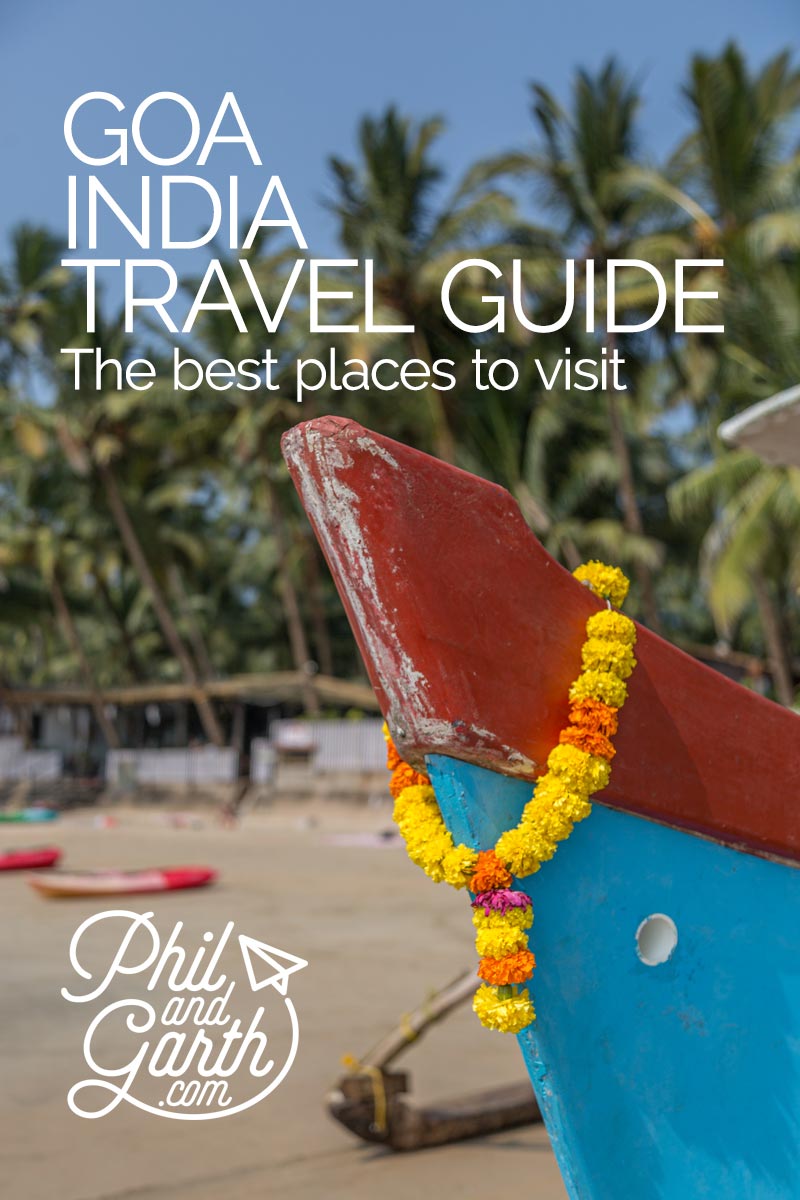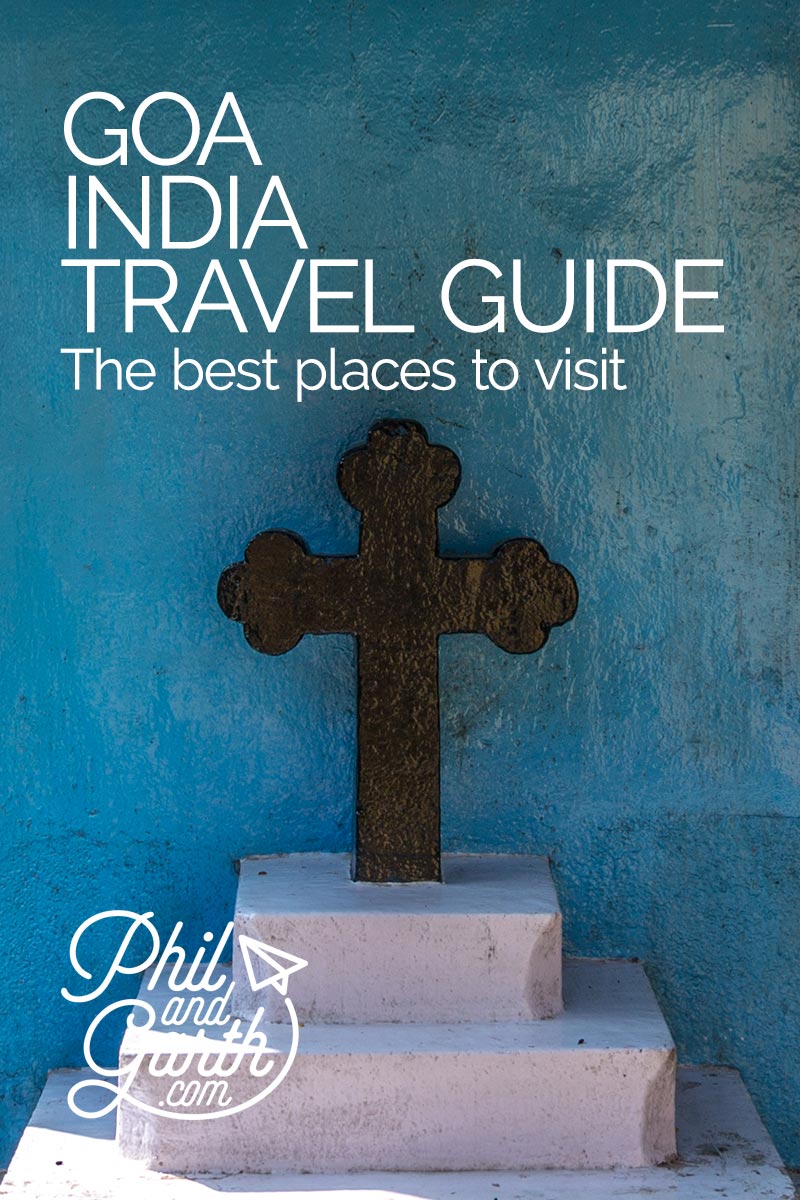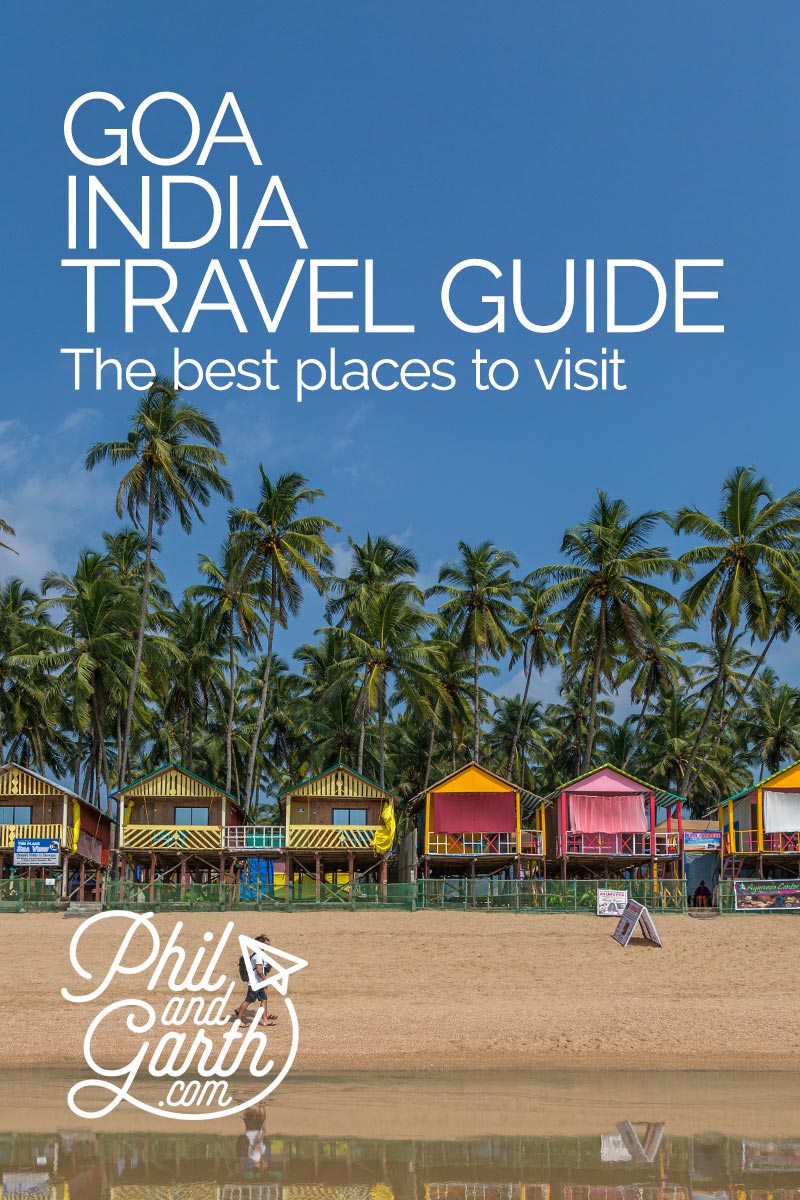Last updated: 24th February 2024
Goa is India’s tropical beach getaway. We decided on a week to recharge under the swaying palms of Goa’s lovely beaches and eat our way through Goa’s Portuguese inspired curry dishes. In this travel guide to Goa we’ll show you all the top places to visit in South Goa & North Goa. Where to find the best beaches and cultural day trips for Goa’s best cathedrals and colonial heritage.
Table of Contents
About Goa – India’s No.1 Tropical Beach Destination
Goa is India’s smallest state and the country’s No.1 beach destination. Famous for its hippy and Portuguese heritage, churches, yoga, beach parties and miles of tropical beaches. Goa is very popular with Brits, Russians and domestic tourists.
Goa is split into 2 unofficial regions – North and South where 48 golden sandy beaches are spread out over 65 miles. All of Goa’s beaches look stunning, the sand is fringed with palm trees and most are long and wide. Goa’s beaches are nowhere near as developed like those in Europe there’s no high rise hotels because they are banned here. The hardest part is choosing a beach, so use our Goa beaches guide to help you, as there is a beach to suit everyone’s taste.
This was our first time in Goa and it was really exciting. Phil was looking forward to just chilling and relaxing by the pool and on the beach, whilst Garth was really excited about the Goa photography tour he booked.
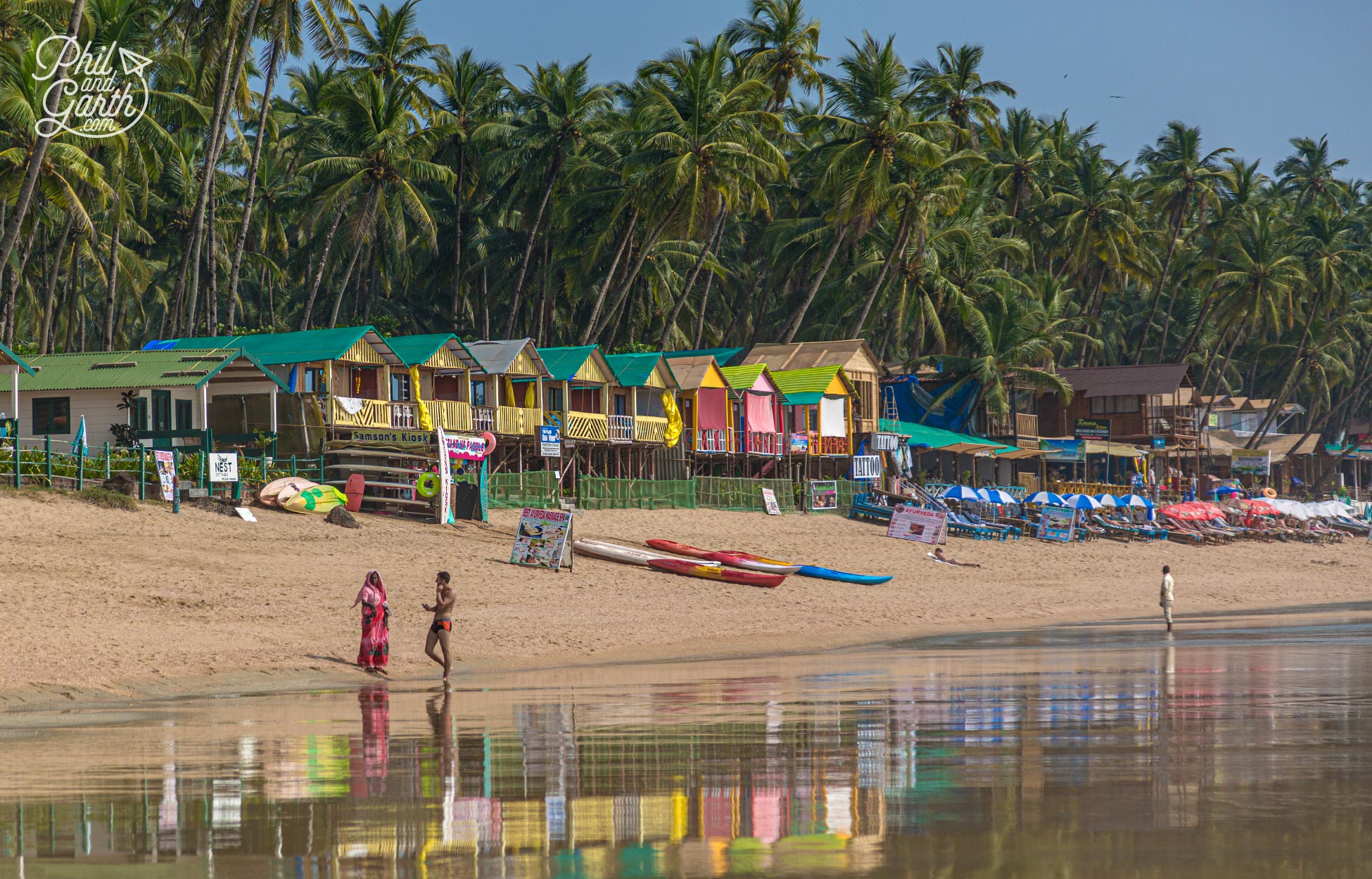
Goa – India’s tropical beach destination
The Best Beaches in Goa
North Goa
North Goa was the first area to be developed in the 1960s when the hippies arrived and decided to stay. Trance parties followed in the 1980s and the 1990s saw commercial tourism arrive. North Goa’s miles of golden beaches are lined with beach shacks that are backed by lots of lively resorts.
North Goa is best for those seeking fun filled days, nightlife and cheap package holiday deals.
North Goa also offers lots of cultural sightseeing – Old forts and UNESCO Heritage Sites in Old Goa and Panjim. (more on these later)
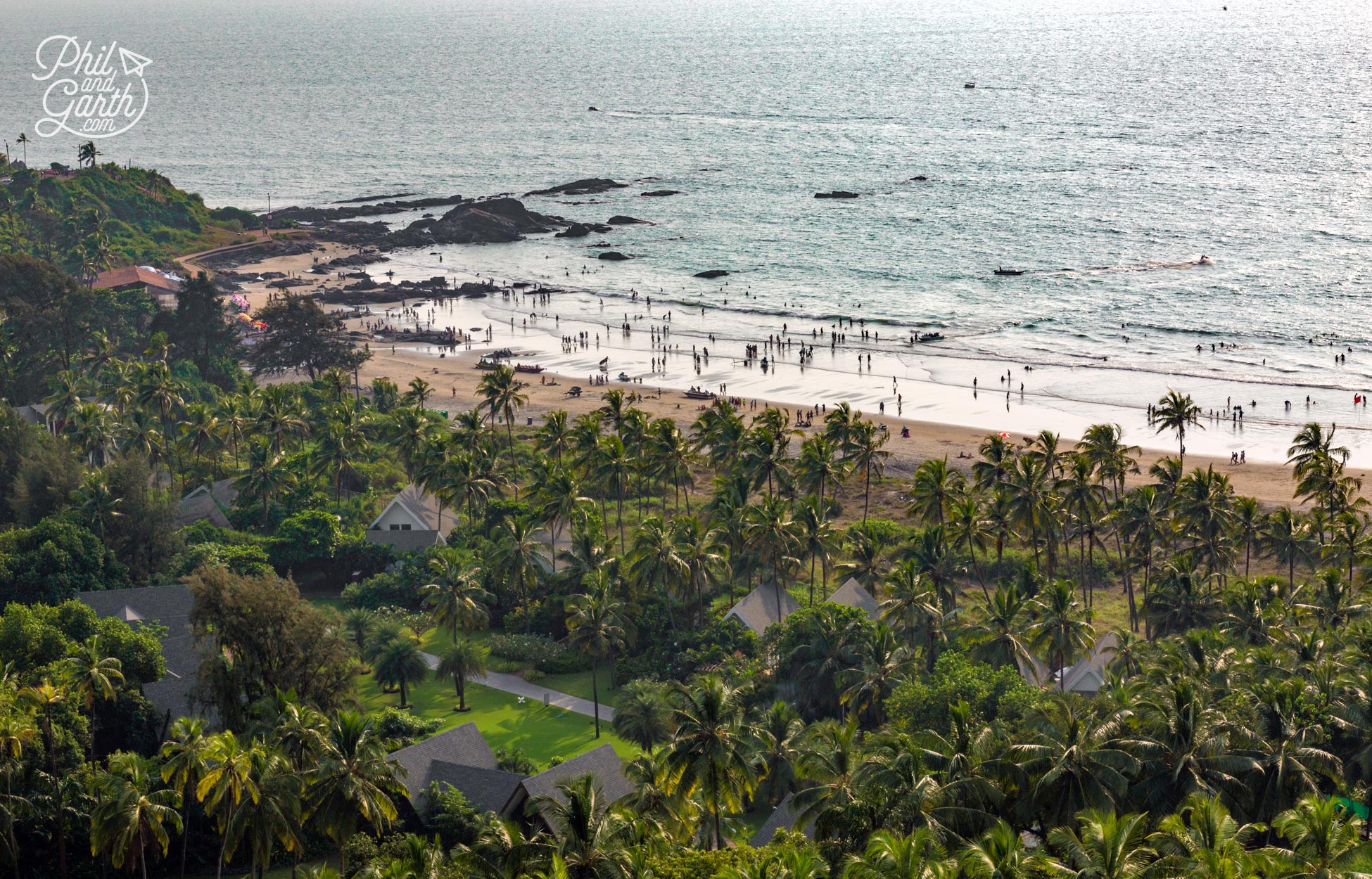
Beautiful Vagator Beach, North Goa
Summary of North Goa beaches:
- Calangute Beach – Most popular and packed of all the beaches in Goa. A lively resort town for nightlife, neon-lit bars, massage parlours and water sports popular with hoards of Brits and domestic tourists.
- Baga Beach – Next to Calangute beach it’s pretty similar – busy, good for watersports, lively nightlife with regular DJ parties and famous Cafe Mambo. Very busy at weekends.
- Candolim Beach – Less crowds, some beach shacks, popular with honeymooners and an older crowd seeking sun, sea and sand.
- Sinquerim Beach – Next to Candolim beach – nice beach, good for water sport activities and swimming has an old fort – Aguada Fort.
- Anjuna Beach – Goa’s most famous beach. Used to be home to full moon all night parties. Anjuna is popular with backpackers still has its famous hippie flea market every Wednesday. Big name DJs play at chilled out music and trance parties.
- Vagator Beach – Beautiful clean beach, no beach shacks and much less crowded. India’s first W Hotel is located here. popular for sunset viewing.
- Mandrem Beach – Quieter spot in North Goa for relaxing with great water sports.
South Goa
South Goa is less developed and quieter with a more laid-back vibe. The beaches here are relatively empty and unspoilt. South Goa offers the largest choice of beach hut accommodation, luxury hotel resorts and eco accommodation. It also attracts those looking for yoga and mediation, organic food and weed! (it’s illegal). Beyond the beaches sightseeing options in South Goa include visiting old Portuguese mansions, churches, sleepy fishing villages, rain forests and spice plantations.
South Goa is best for those looking for peace, tranquility and independent travel options.
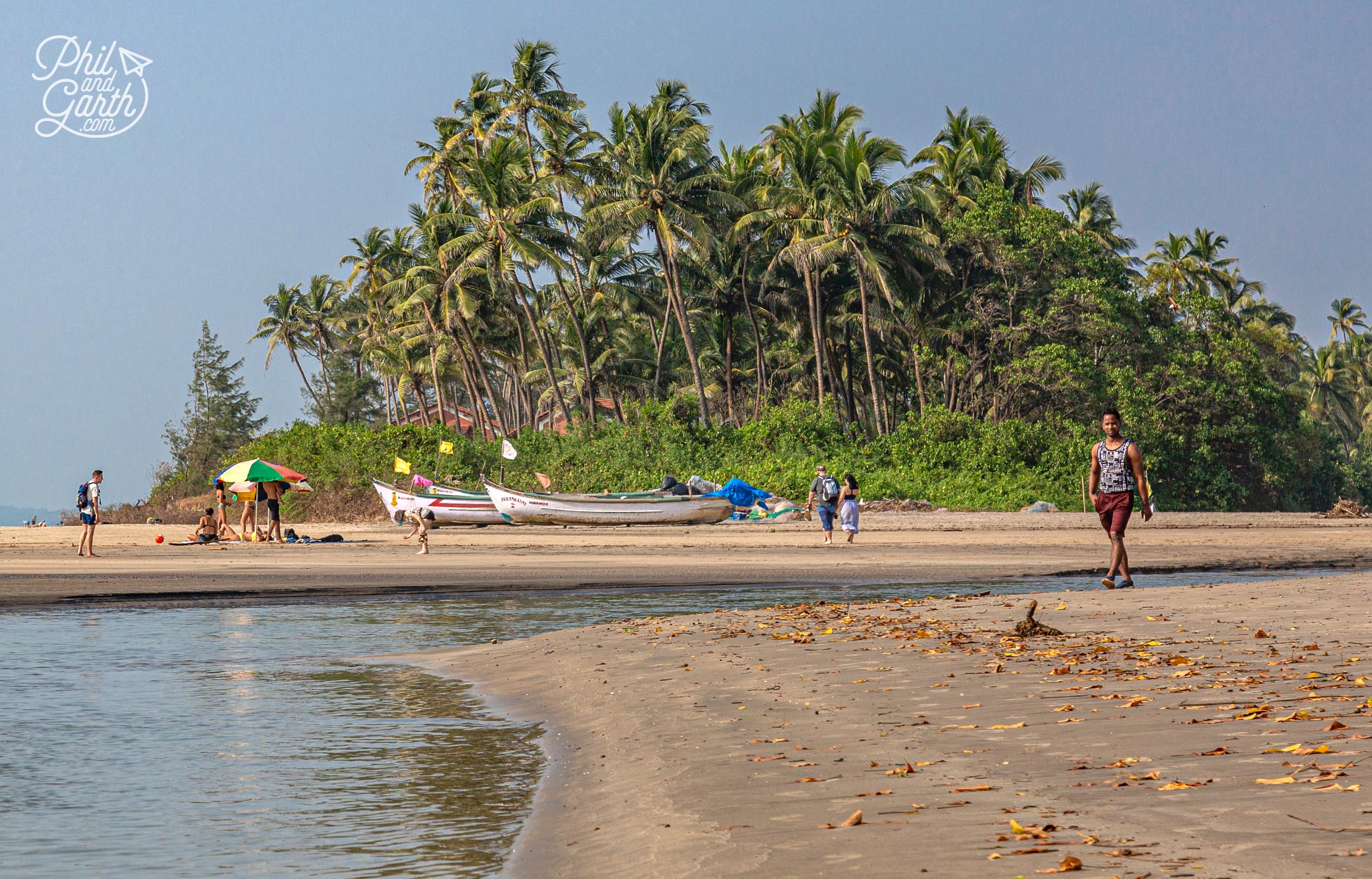
Tranquil beaches tend to be in South Goa
Summary of South Goa Beaches:
- Cola (not Colva ) – Unique beach because it has a lagoon, it’s a peaceful and private place.
- Benaulim – Quiet, laid back and very clean beach, 18 miles South of Panjim. Known for handicrafts sold here.
- Agonda Beach – Quiet beach, picturesque, undeveloped with beach hut accommodation perfect for chilling out.
- Palolem Beach – Goa’s Scenic beach in all the brochures, quite touristy but with a laid back vibe, some nightlife and beach hut accommodation.
- Patnem Beach – Next to Palolem Beach, a small unspoilt beach perfect for chilling out in rustic beach hut accommodation.
- Cavelossim – Unspoilt big beach with a handful of beach shacks next to many luxury hotels.
Picture Postcard Palolem Beach, South Goa
This is South Goa’s picture-postcard beach, it’s beautiful, we loved it here. A curved bay with golden sand lined with coconut palm trees and colourful beach huts. It used to be Goa’s hidden gem, a bit less so now.
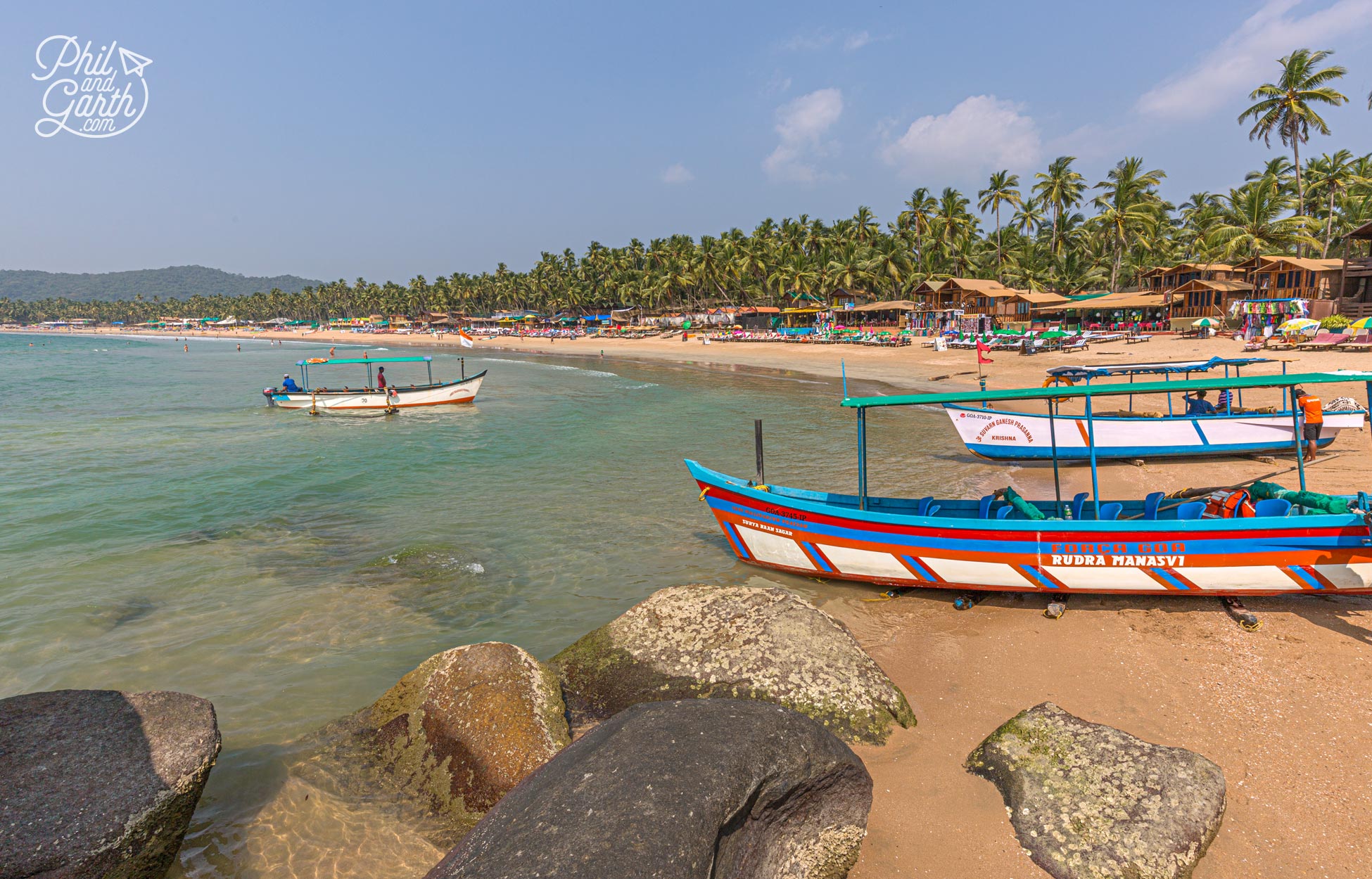
Gorgeous Palolem Beach in South Goa
It’s the most popular beach in South Goa and attracts an eclectic crowd, we thought it has a bit of a Glastonbury vibe about the place. The North side of the beach is quieter and popular with families, whilst the south end has a more party vibe and popular with backpackers. There’s very little in the way of nightlife here however they do host silent noise parties on Saturdays.
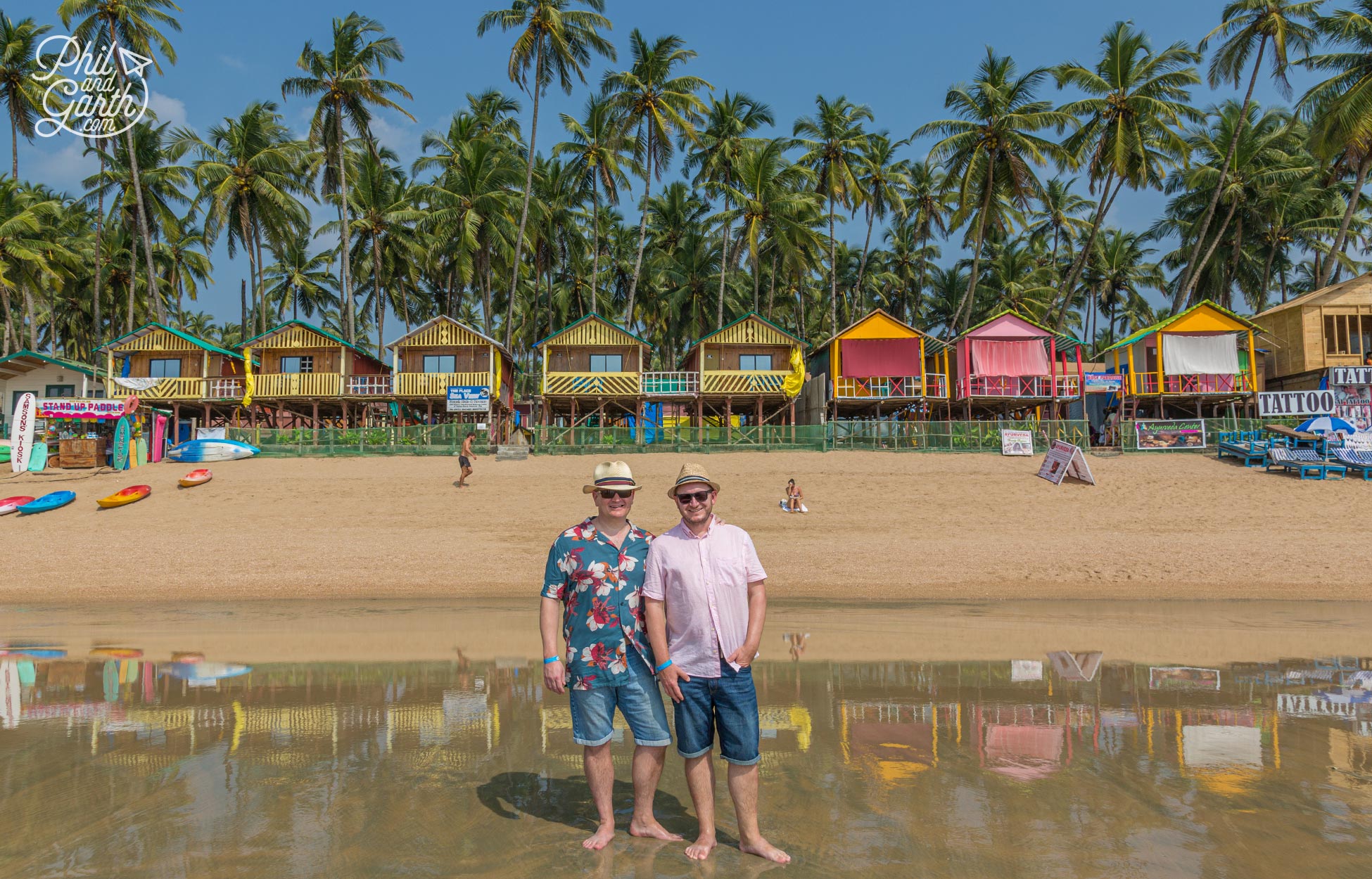
Phil and Garth on Palolem Beach, South Goa
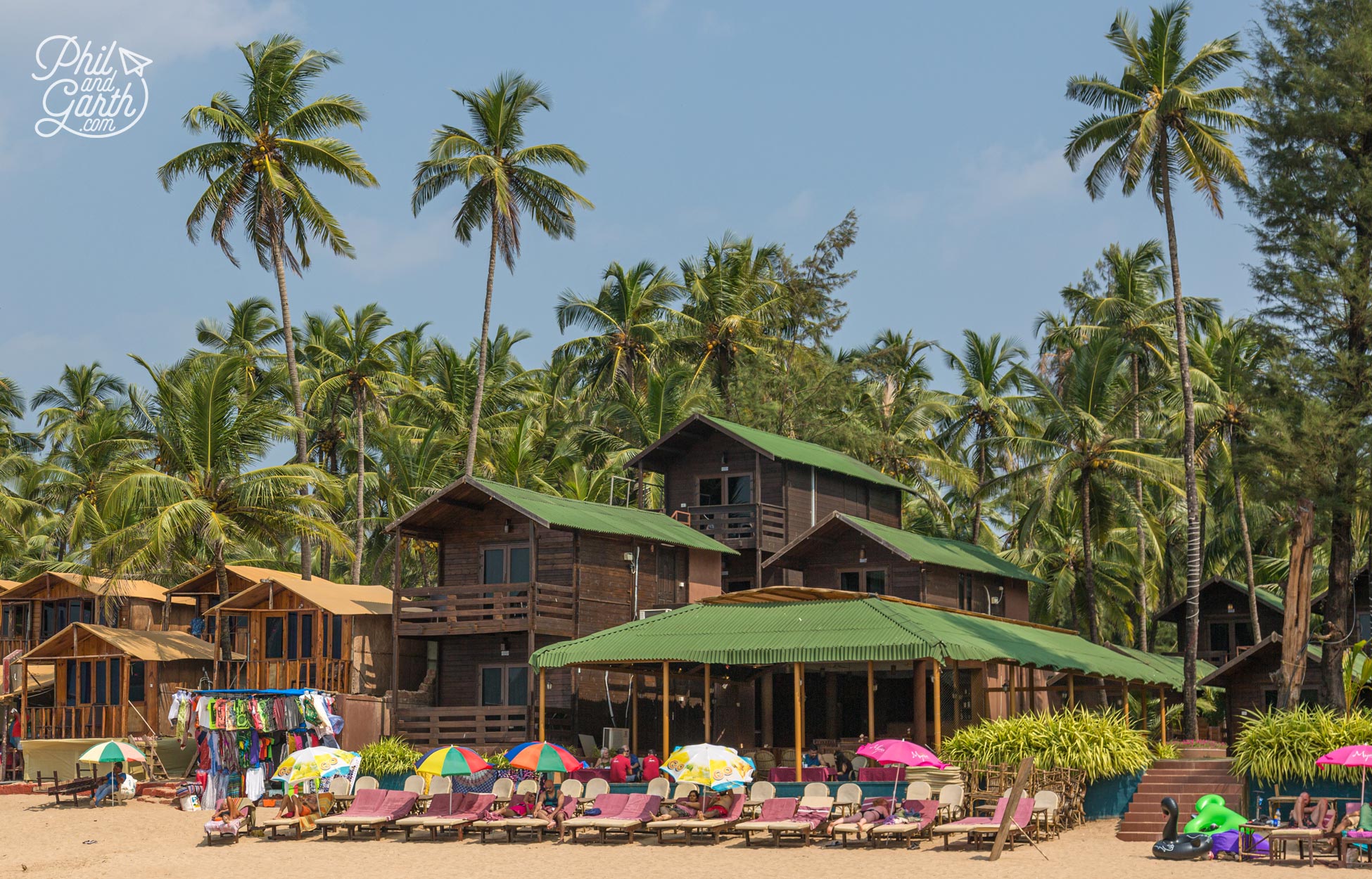
Beach hut accommodation on Palolem Beach
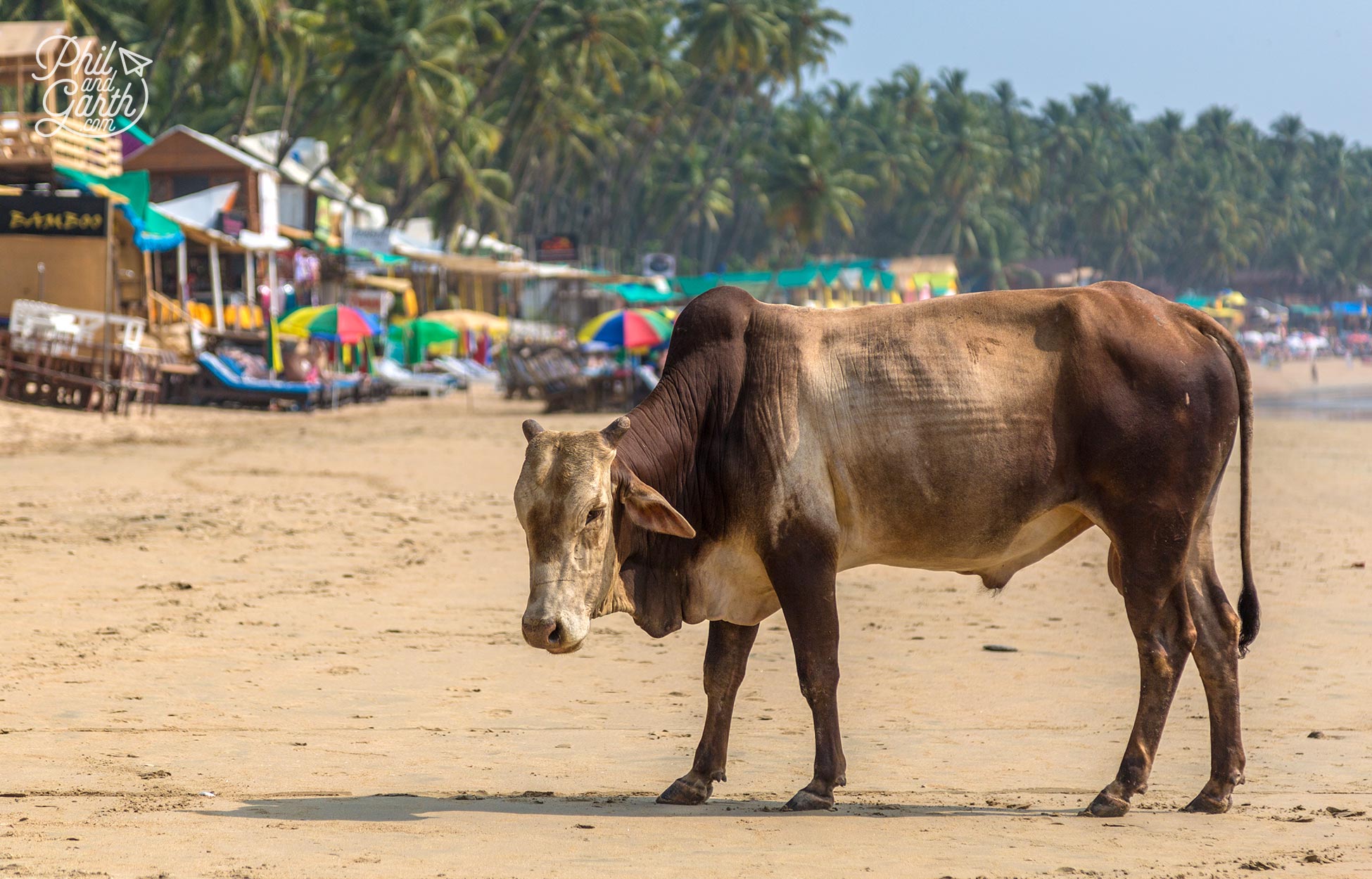
Don’t be surprised to see holy cows wandering around freely on the beach
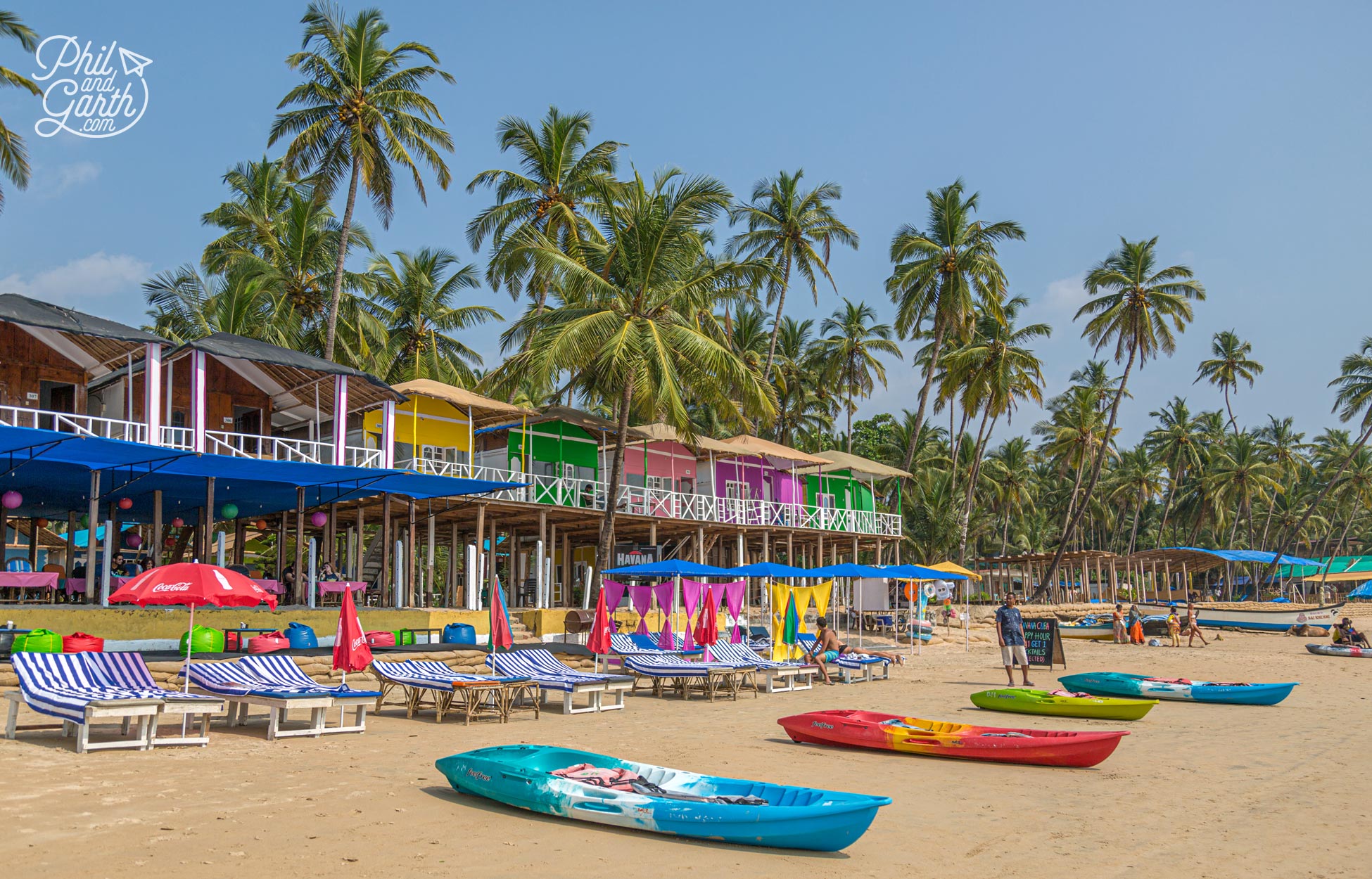
Palolem is lovely and colourful!
The stand-out attraction is the beach hut accommodation, there’s tons of choice right on the beach. We’re definitely going to stay in one next time we visit Goa, we liked the look of Ciarans sea view huts. Our friends stayed at the Bhakti Kutir Beach Houses just behind the beach, which also look lovely.
Whilst the sea isn’t the best for swimming, you can go kayaking and dolphin spotting. People will try sell you boat trips or massages on the beach but there’s no pressure, there’s no hard sale which we liked. There’s tons of food options with all the various shacks, plenty of fresh fish curries. For the best vegetarian and vegan food head to Zest.
We loved Palolem Beach, just pick a bar and you’ll get a free sun lounger, free wifi and personal service all day. We chose the Tide Exotica beach shack, a full day ordering beers and lunch cost us 2,600 IRN (£27). Our favourite moment was having a spicy curry in the shade with a red hot naan bread, feeling super relaxed and looking out to the turquoise Arabian Sea.
It cost us 2,700 IRN (£28) to hire a taxi. The driver took us from our hotel in Cavelossim in the morning, waited all day and took us back in the evening, we thought it was a bargain, so gave him a decent tip.
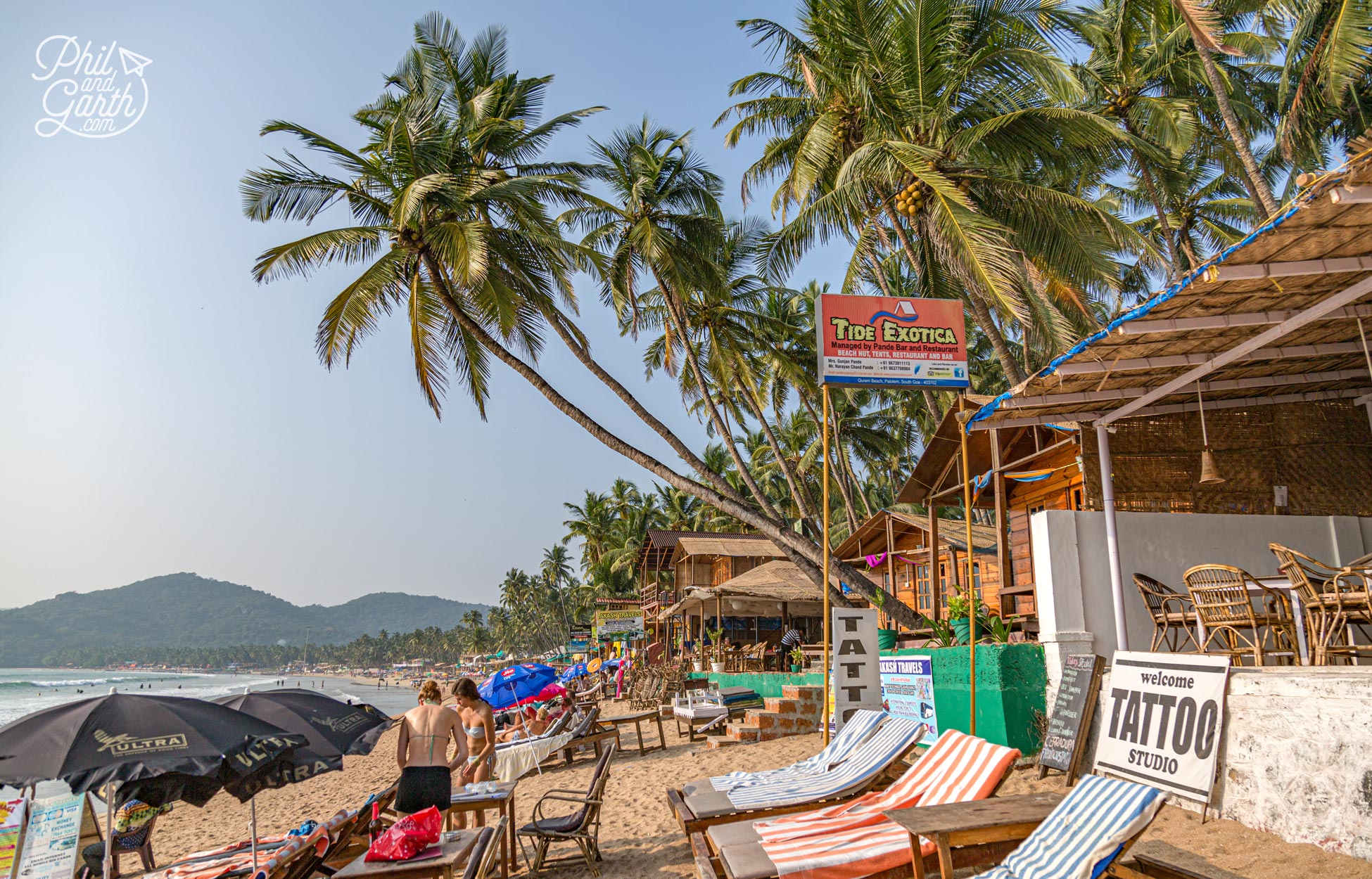
The Tide Exotica beach shack where we spent the day on Palolem Beach
The opening scenes from The Bourne Supremacy (2004) movie starring Matt Damon were filmed right here on Palolem Beach.
Our South Goa Stay – Cavelossim Beach
Our hotel was right next to Cavelossim Beach, it’s beautiful, clean and wide. If you’re lucky you might see dolphins in the water. There’s loads of space and perfect for a long romantic walk along the beach. We went at the start of the tourist season in November so not many shacks had been built. Every year the beach shacks are rebuilt from scratch and taken down before the start of the monsoon season at the end of May.
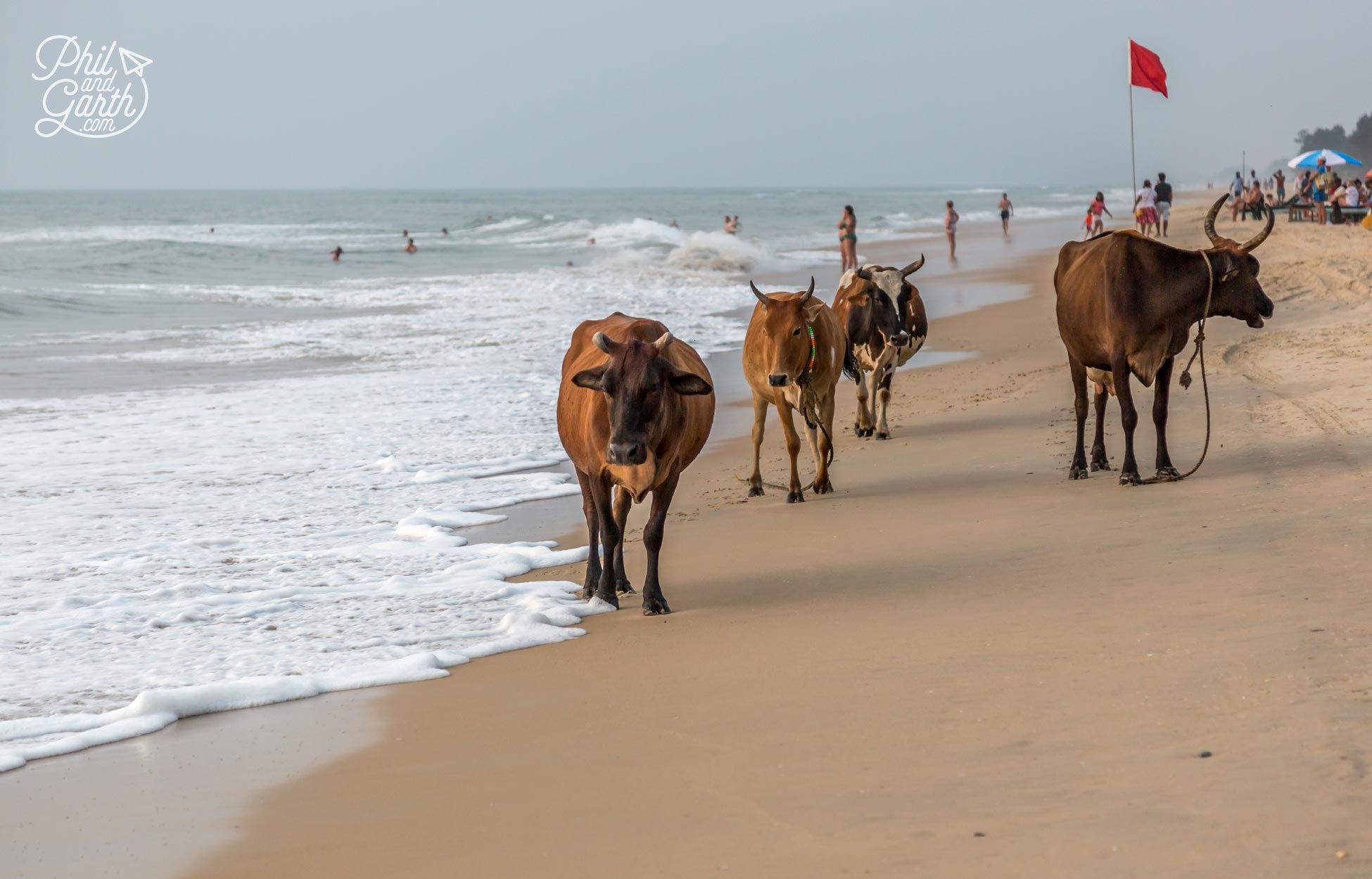
Holy cows on Cavelossim Beach, South Goa
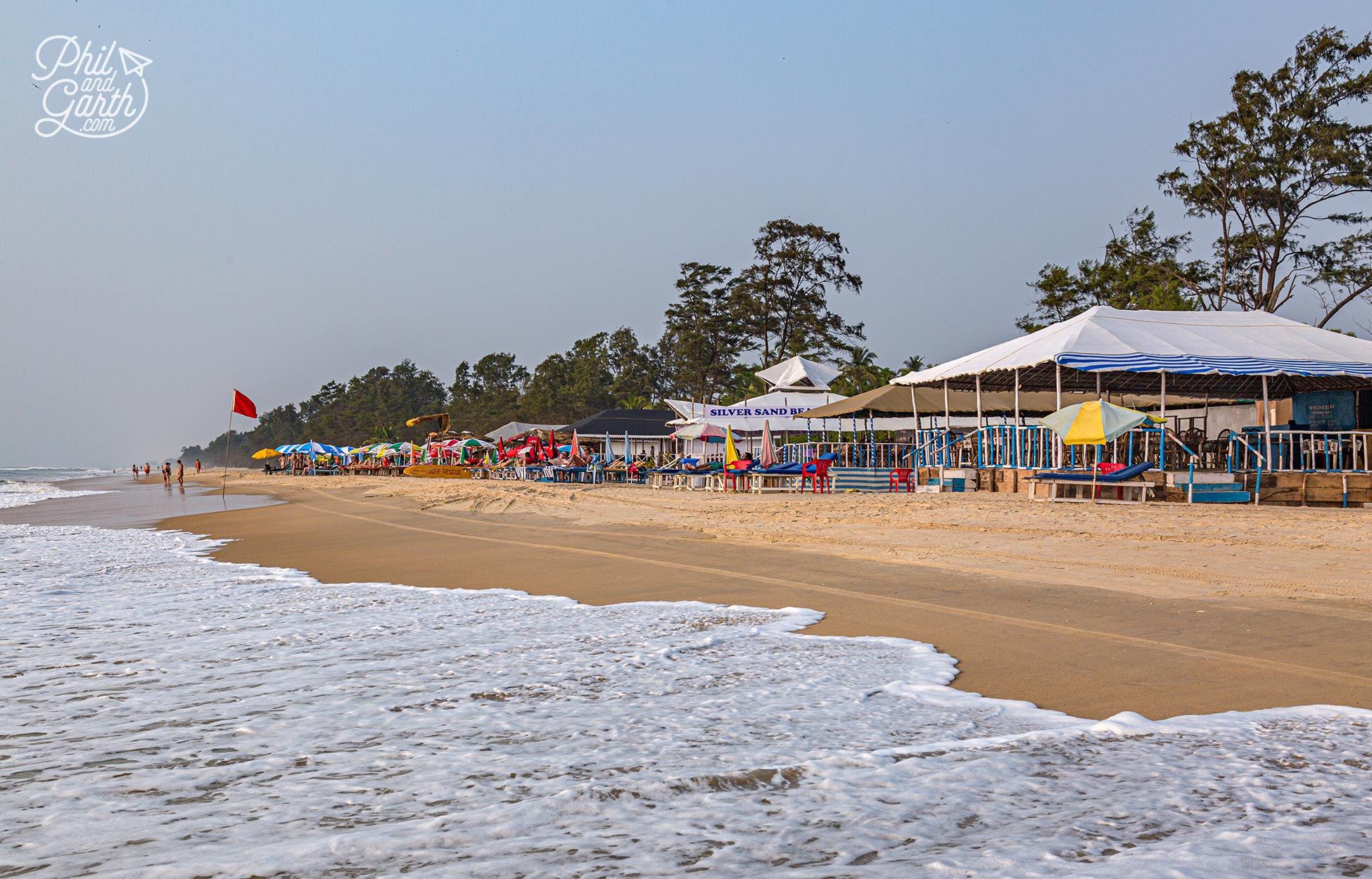
Beach shacks on Cavelossim Beach in South Goa
Portuguese Goa
Over many centuries Goa was ruled by various dynasties including the Portuguese for which it’s most famous for. After 450 years the Portuguese rule ended in 1961 when they were kicked out by the Indian Army. Portugal’s legacy is left with old colonial buildings, hundreds of churches and their influence on food.
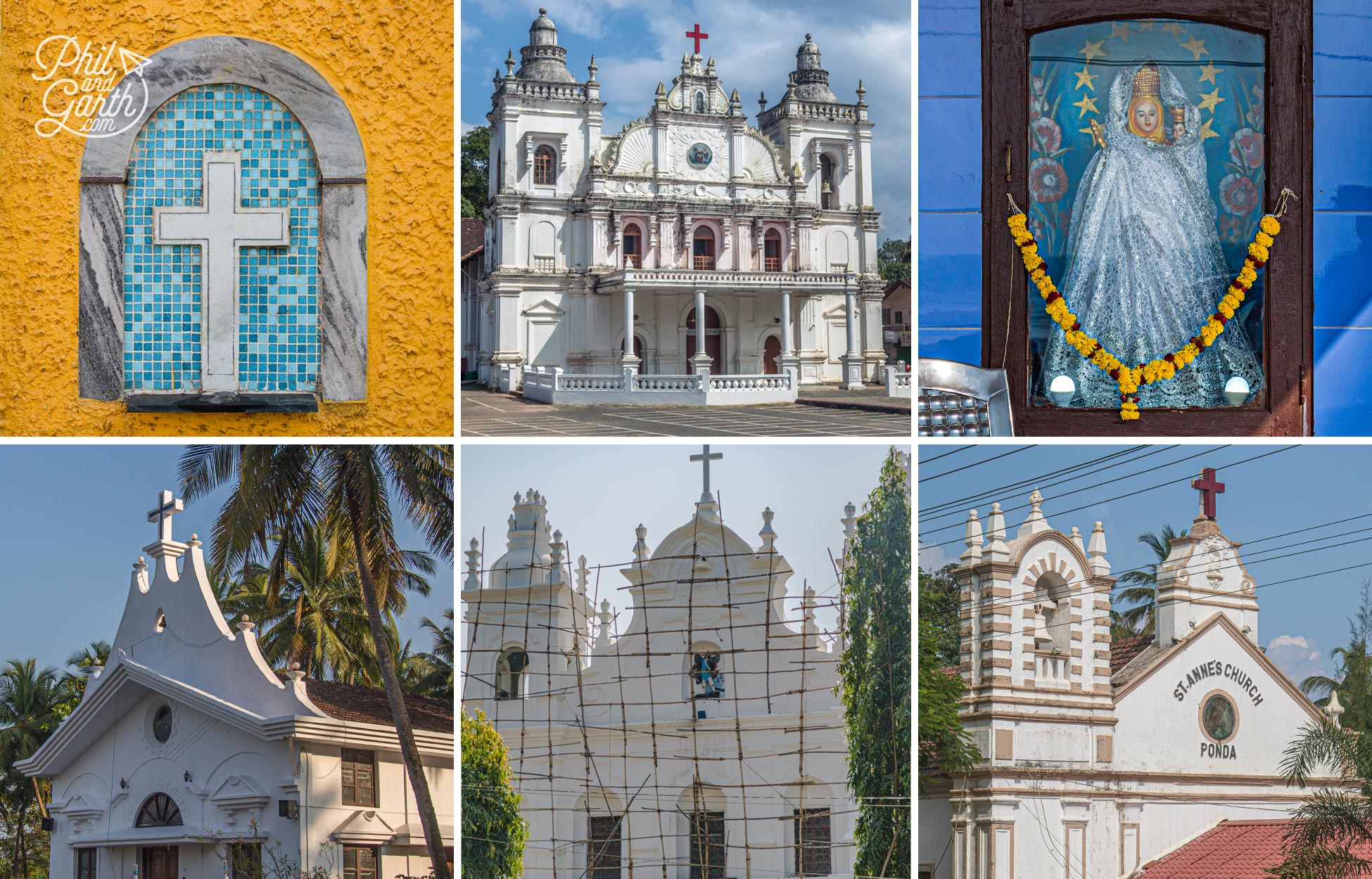
The Portuguese brought Catholicism to Goa and built hundreds of churches
A Brief History of Old Goa – Velha Goa
Old Goa, also called ‘Velha Goa’ is a UNESCO World Heritage Site. It was the former capital of Portuguese-India built on the banks of the Mandovi River. The city was rich and an important trading post with a large population, larger than Lisbon in its day. The Portuguese brought Catholicism to the region and built many churches and European style homes and became known as ‘Rome of the East’. However Old Goa suffered an outbreak of the plague, malaria and cholera. The epidemic became deadly so the city was abandoned in 1843 and the capital was rebuilt and shifted to nearby Panjim.
Today nothing much remains of the old city, because most of the as the city was reclaimed by the jungle. However what is left are 2 imposing churches – The Basilica of Bom Jesus and Se Cathedral.
The Basilica of Bom Jesus
Built in 1605, this is some serious baroque architecture! It’s one of the oldest churches in India and contains the silver tomb of St Francis Xavier. Catholic Indians were going mad here for selfies, it made for quite amusing people watching! as we’ve not seen this sort of behaviour in a church before. It’s the most popular church in Goa and was the first church to be promoted to minor Basilica by the Pope Pius XII.
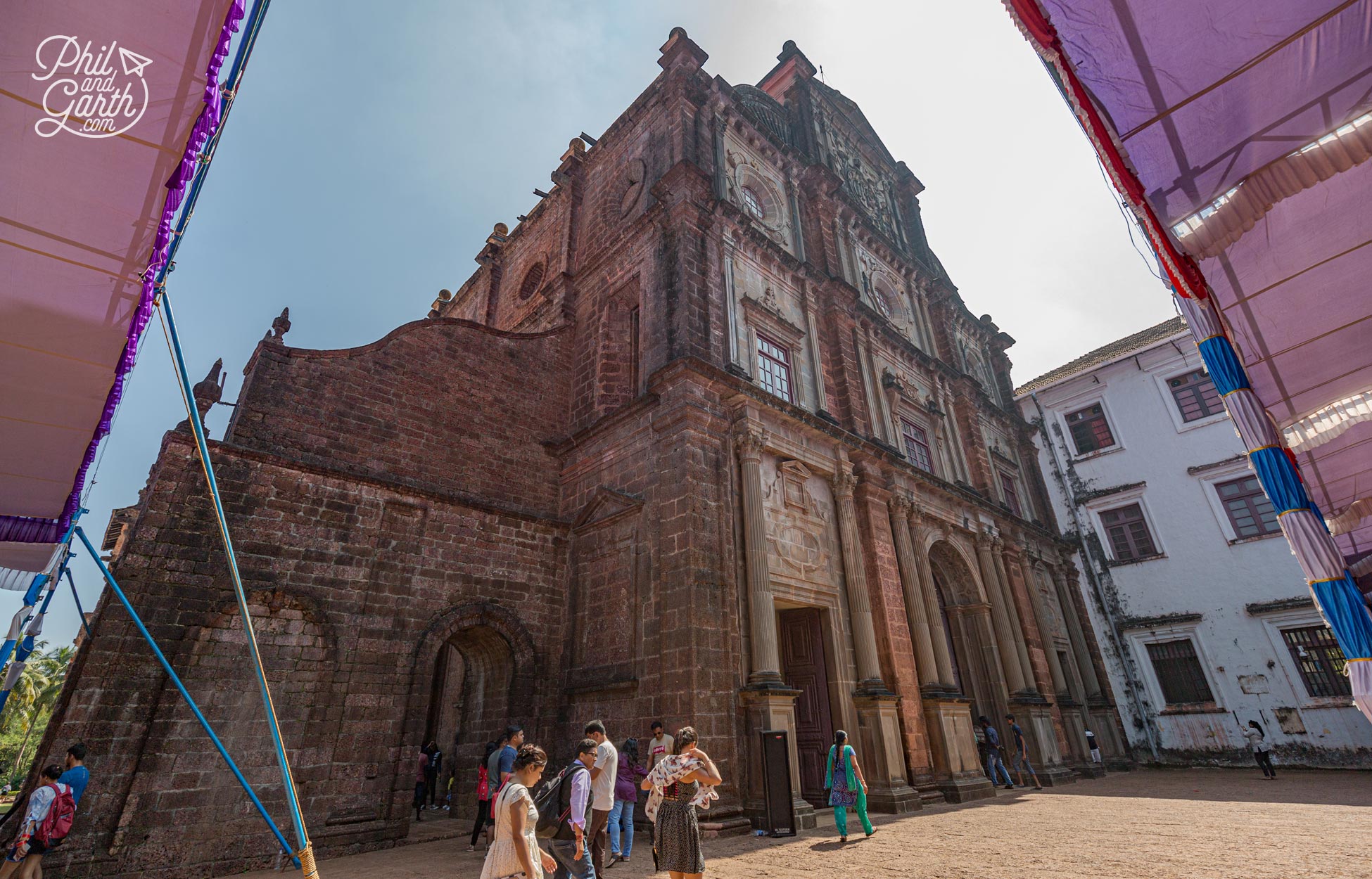
Basilica of Bom Jesus built in 1605
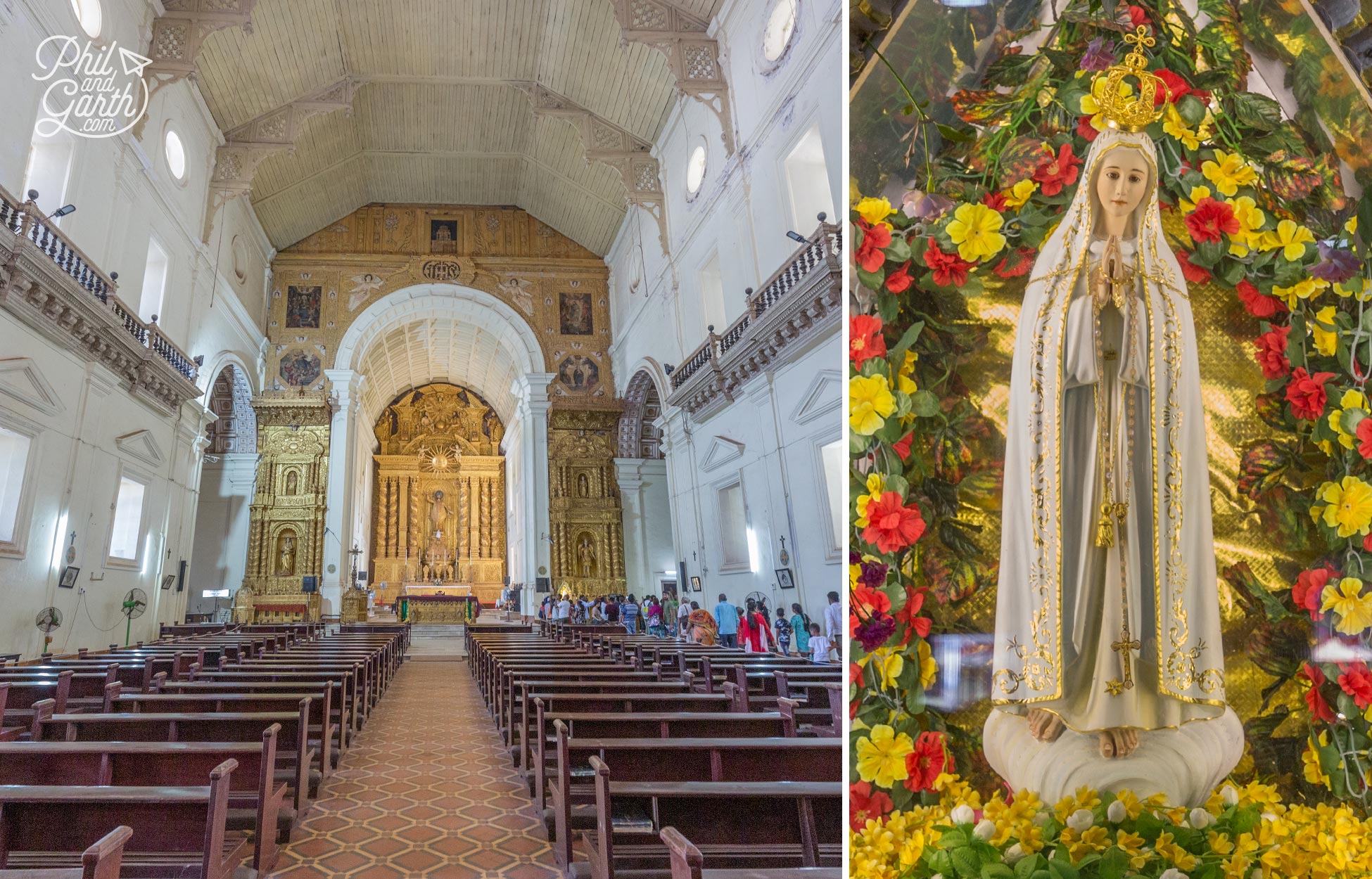
Inside the Basilica of Bom Jesus
Se Cathedral
Just over the road from Basilica of Bom Jesus is the enormous Se Cathedral. It’s the largest church in India and the whole of Asia. Inside they used to hold up to 15 services at once. Aswell as the main alter, there are 4 chapels running down the sides of the aisles.
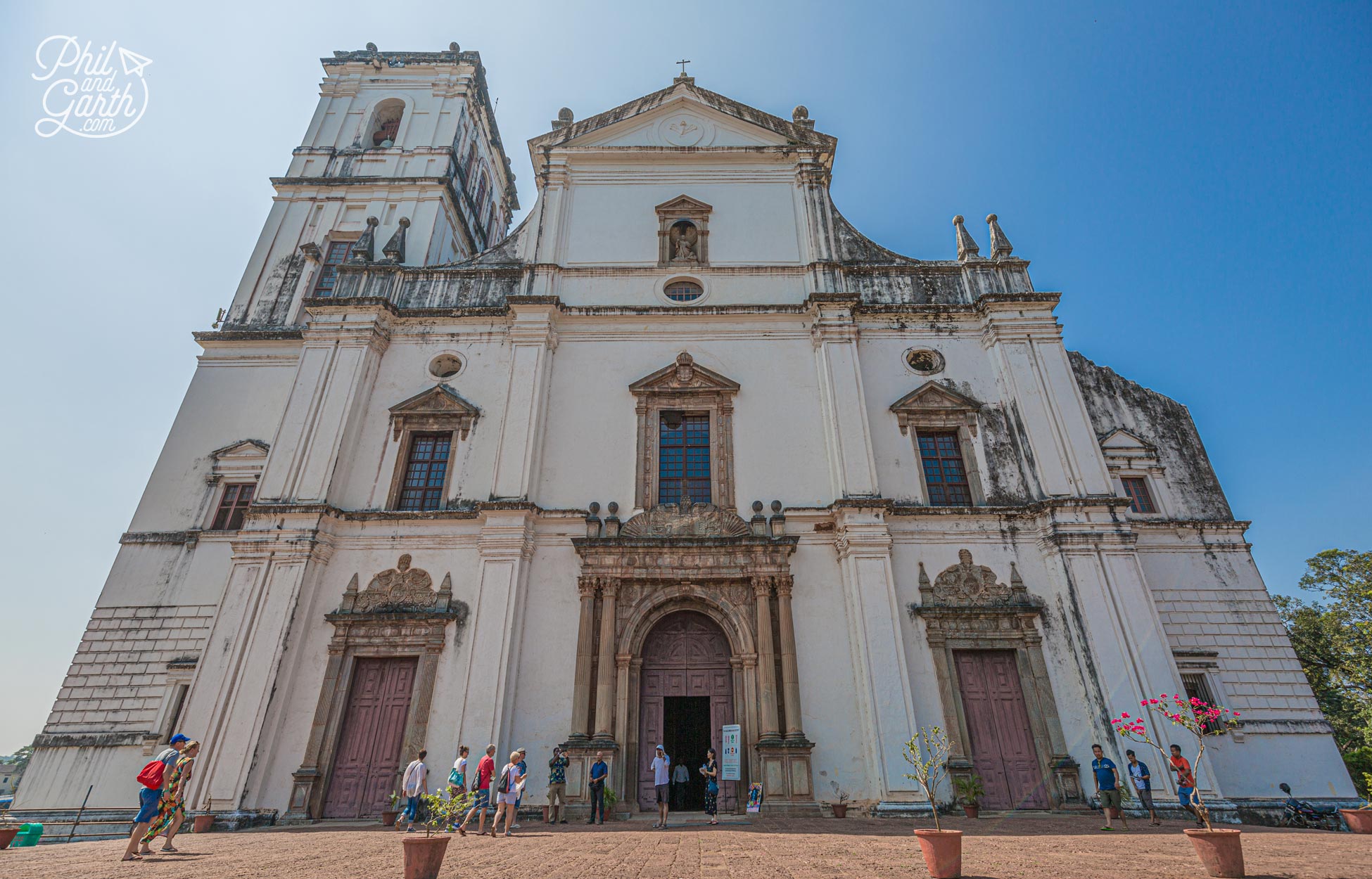
Se Cathedral – The largest church in India and the whole of Asia
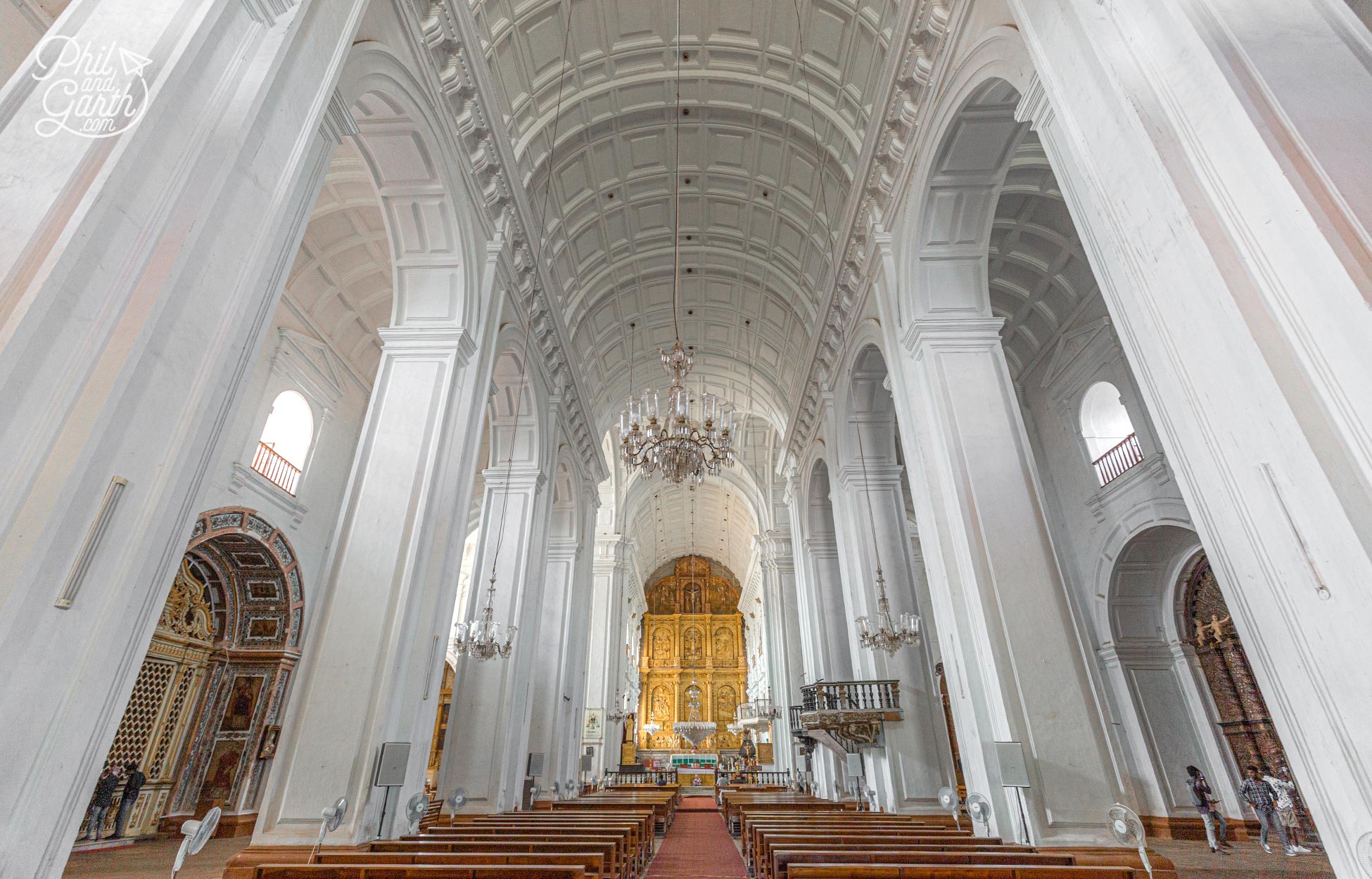
Inside the Se Cathedral, built in 1619 it took 57 years to build
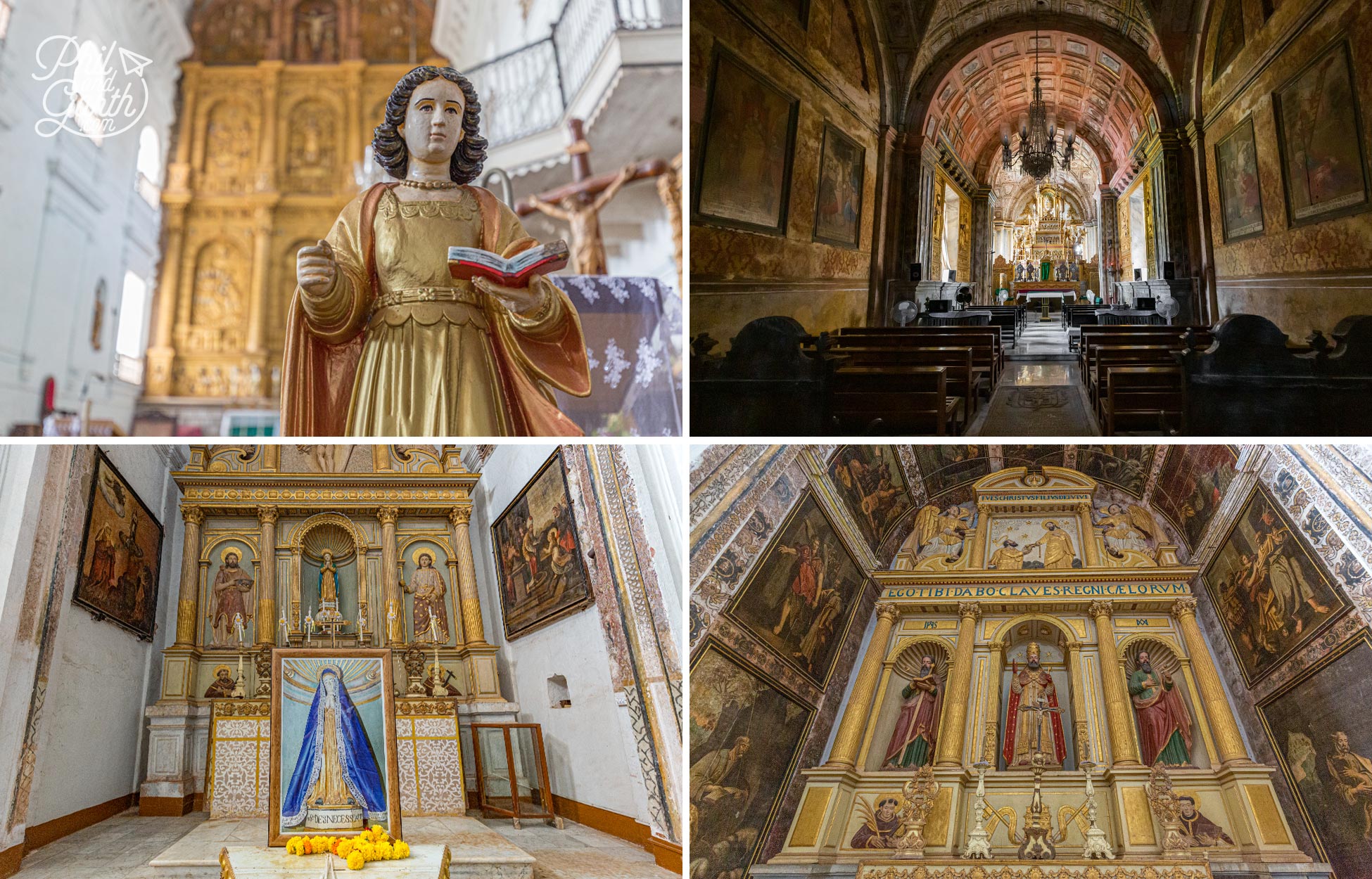
Details of the decorative and gold altars
Panjim – Goa’s Capital City
Goa’s Portuguese colonial past is best seen in the capital, Panjim (or Panaji). Wander around the back streets of Fontainhas – the Old Latin Quarter and check out the charming colourful houses. It’s a UNESCO Heritage Zone and mostly a residential area. We loved walking around these narrow cobbled streets looking inside beautifully crafted doorways and up at the cute balconies. It’s peaceful and feels like you are in Europe with the terracotta roofs and bright colours. When you’re done here you can head up to the hill and check out another white washed church – Our Lady of the Immaculate Conception. It was the first church to be built in Goa in 1541. It has some distinctive zig-zag stairs at the front.
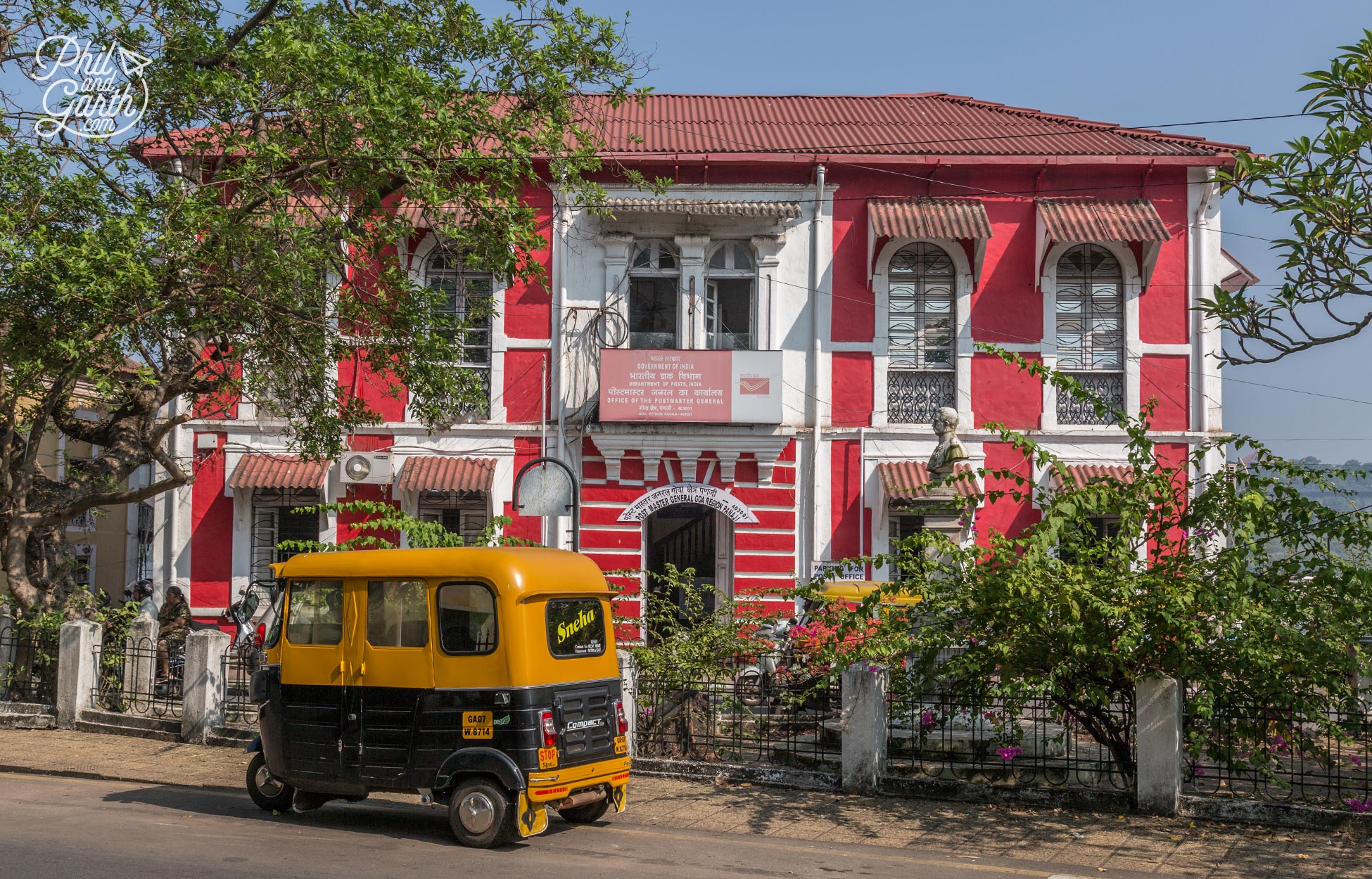
The Post Office building in Panjim
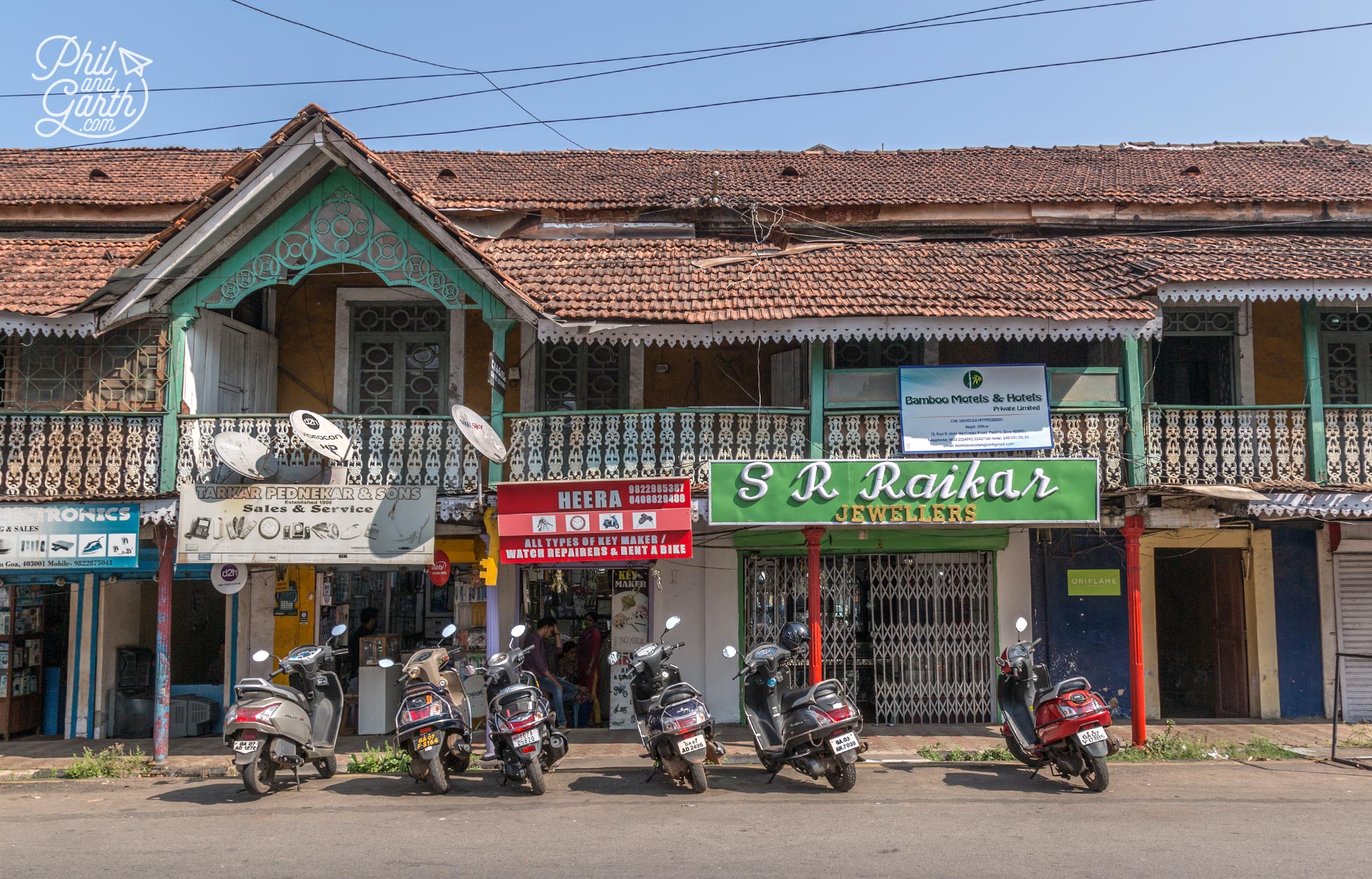
Some lovely wrought iron balconies on these old buildings
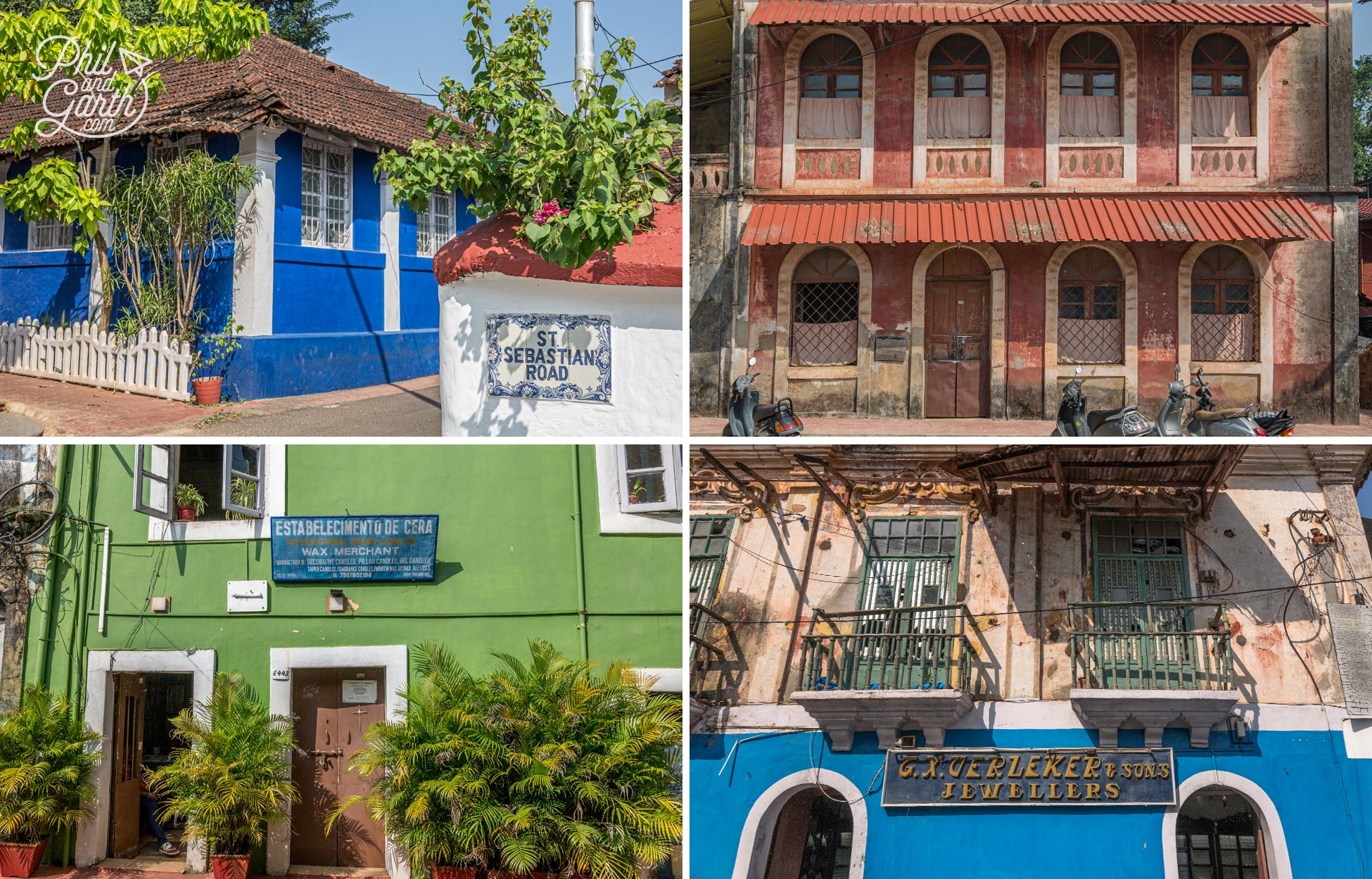
Walking around the Fontainhas – the colourful latin quarter of Panjim
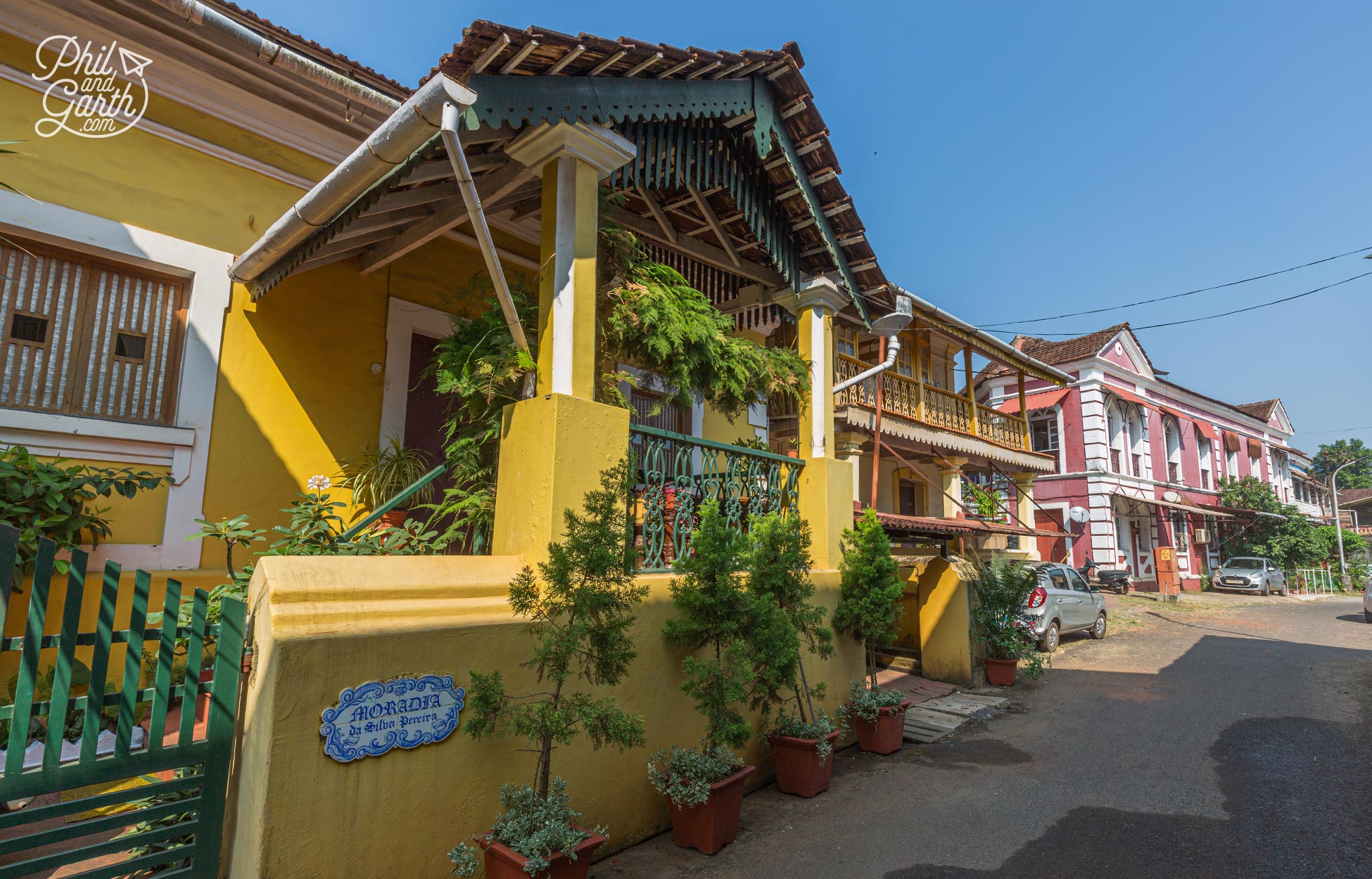
Yellow painted buildings used to signify a government building
The buildings used to be colour coded – purple painted buildings were home to people who worked in church. Yellow was a government building. All these buildings had to be painted every year after each monsoon by law. Today the tradition is still practiced by some locals. Look out for rooster ornaments on the rooftops – they are said to bring good fortune.
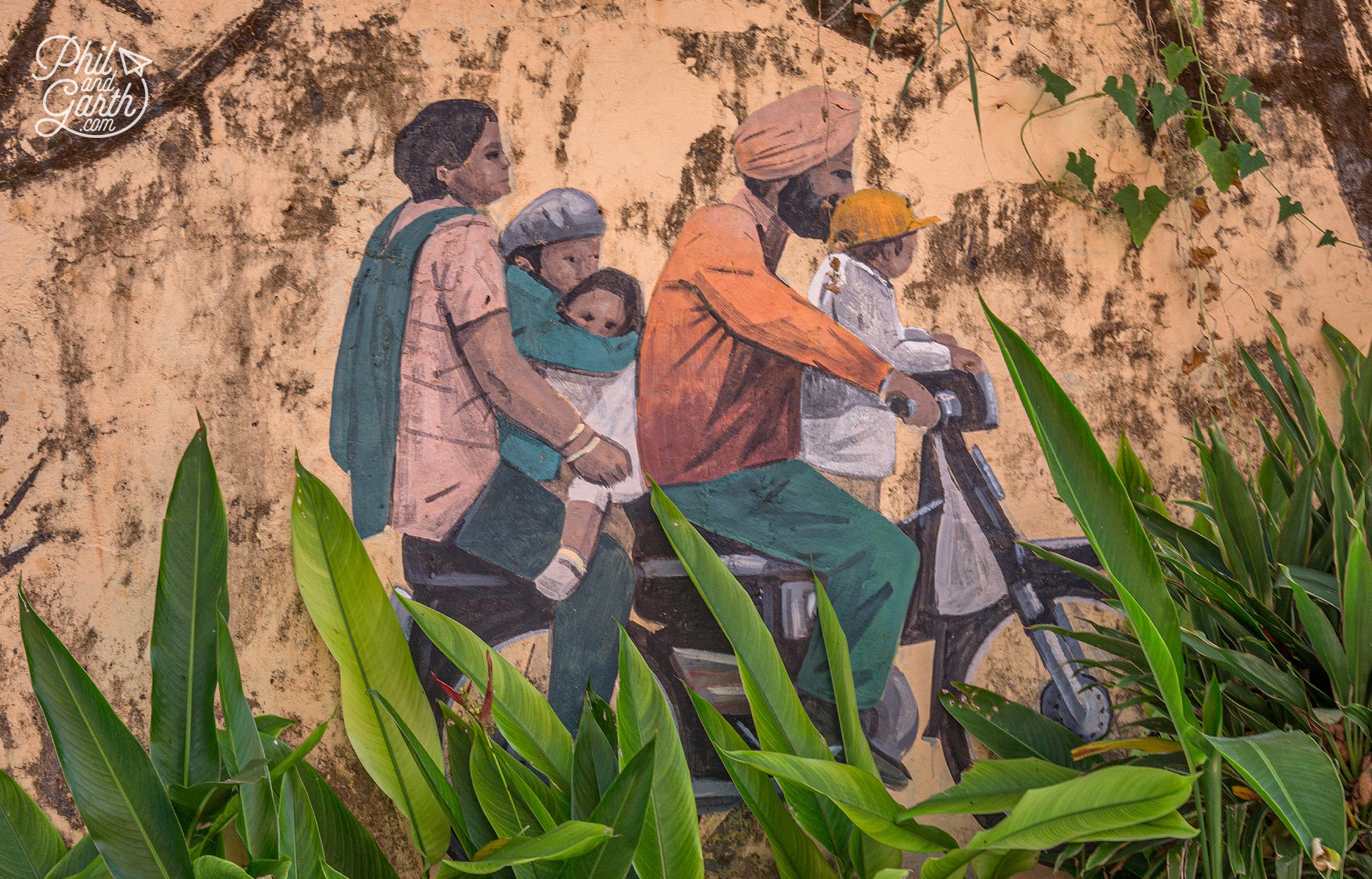
A small piece of street art
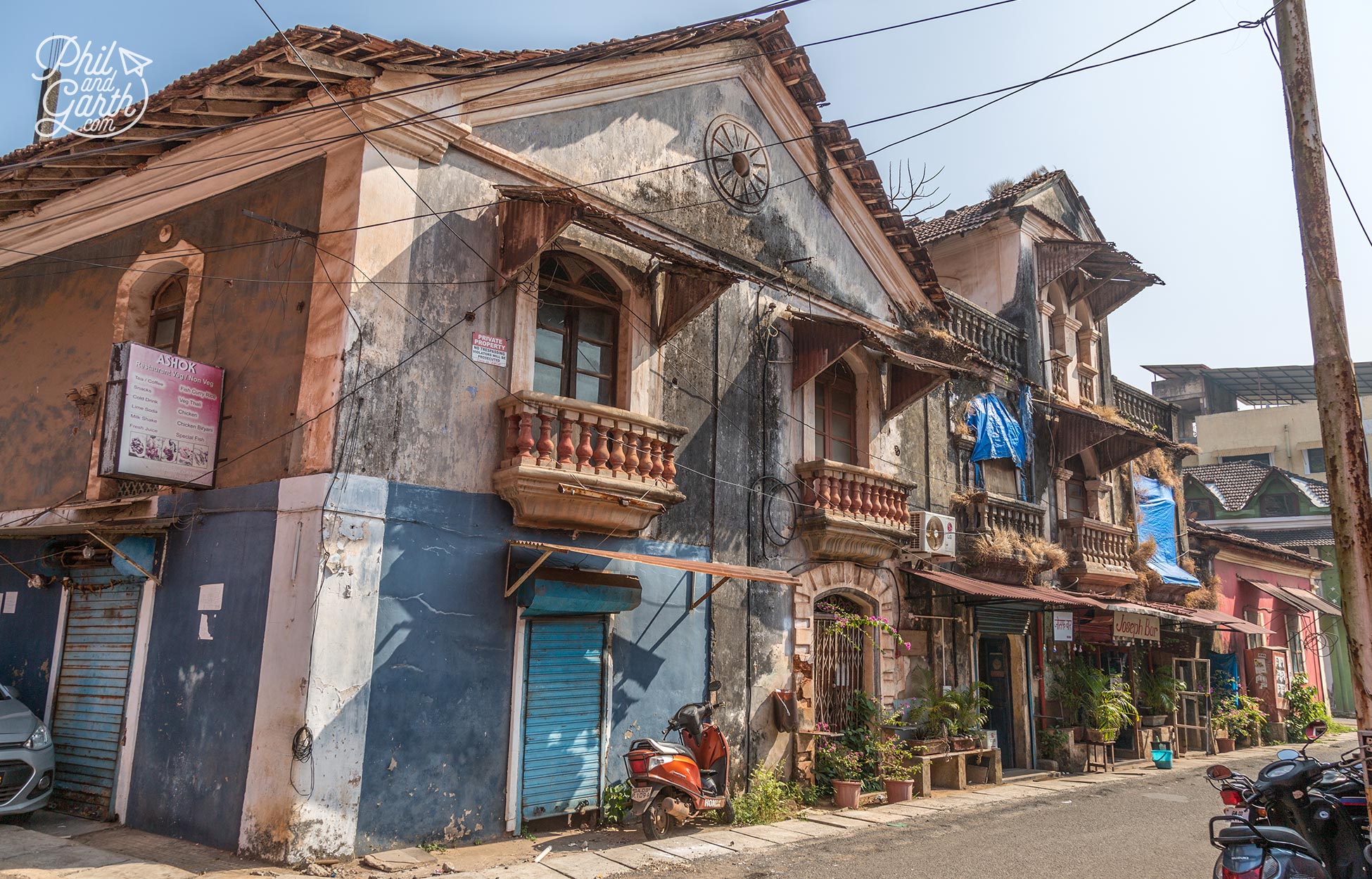
Crumbly old buildings have some nice cafes
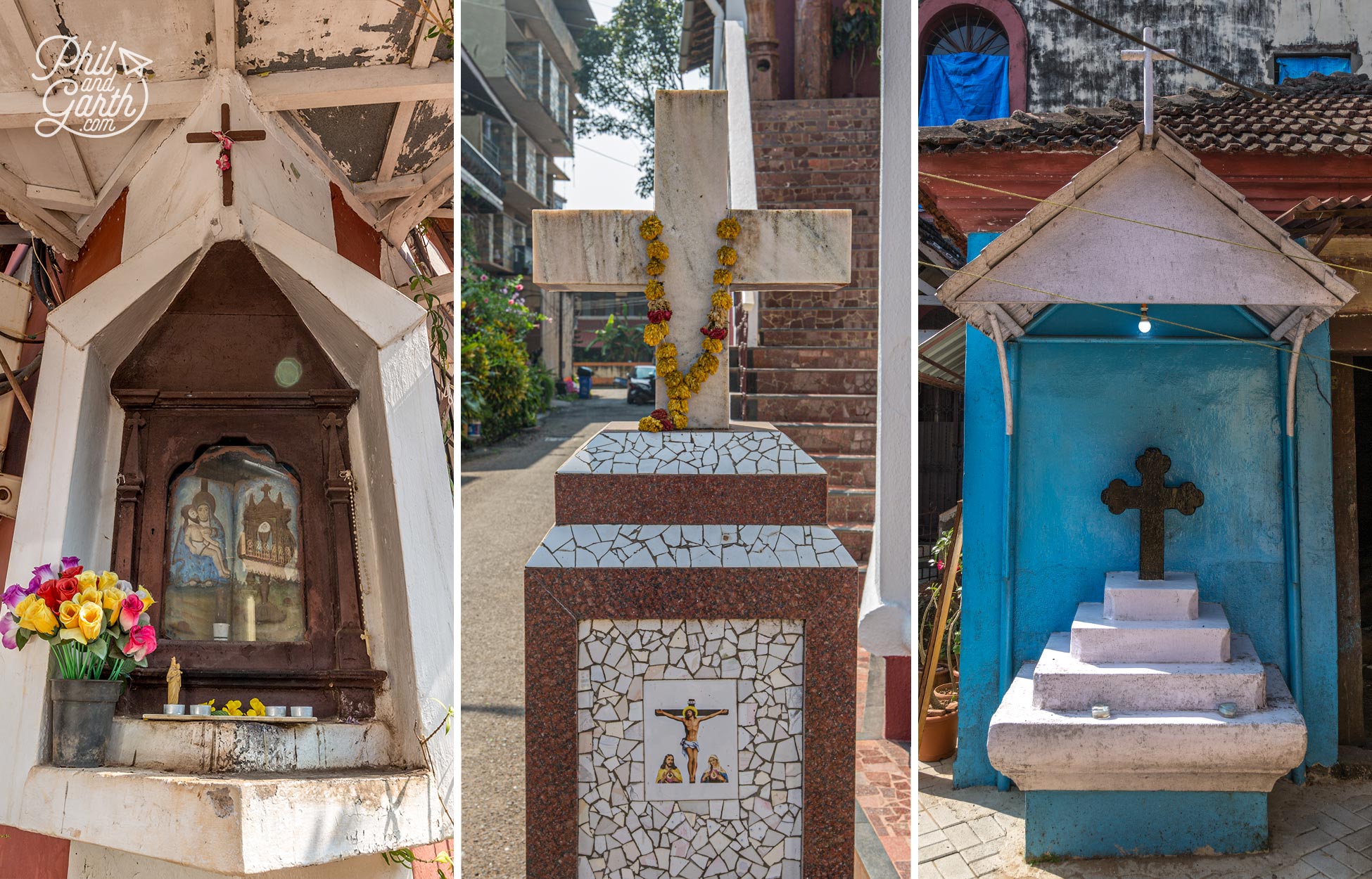
Around every corner in Fontainhas we discovered lots of small catholic shrines
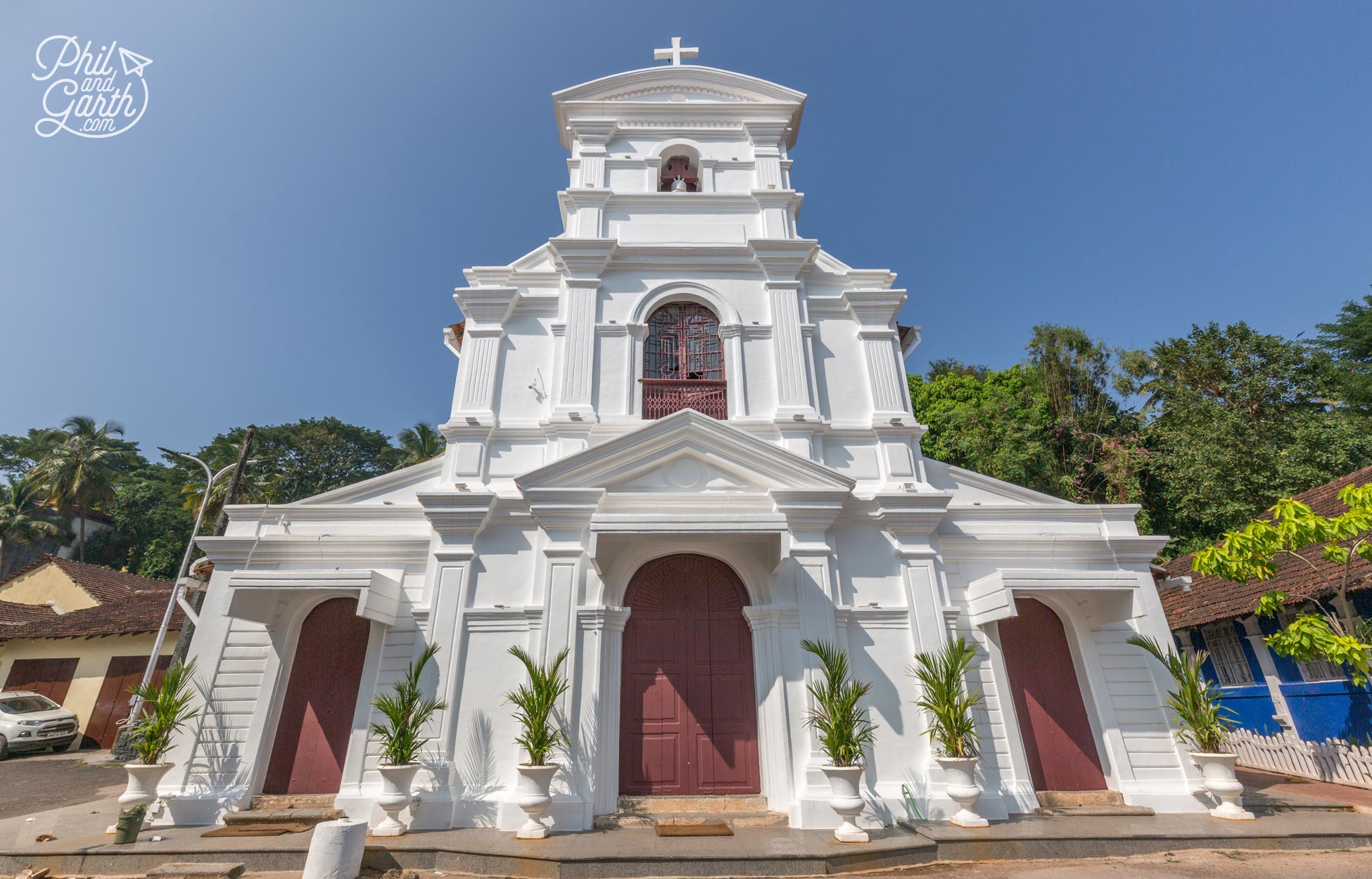
Another grand church – Built in 1818 The Chapel of St Sebastian
Goa Day Tours
North Goa Photography Tour
Whilst we were staying in Goa we took the opportunity to try a photography tour. It was amazing! We explored food markets in Mapusa and visited fishing villages. You can read more about that in our separate post. Local photographer Francisco de Souza taught us camera techniques and showed us Goa in an authentic way by taking us to places we’d never have found by ourselves.
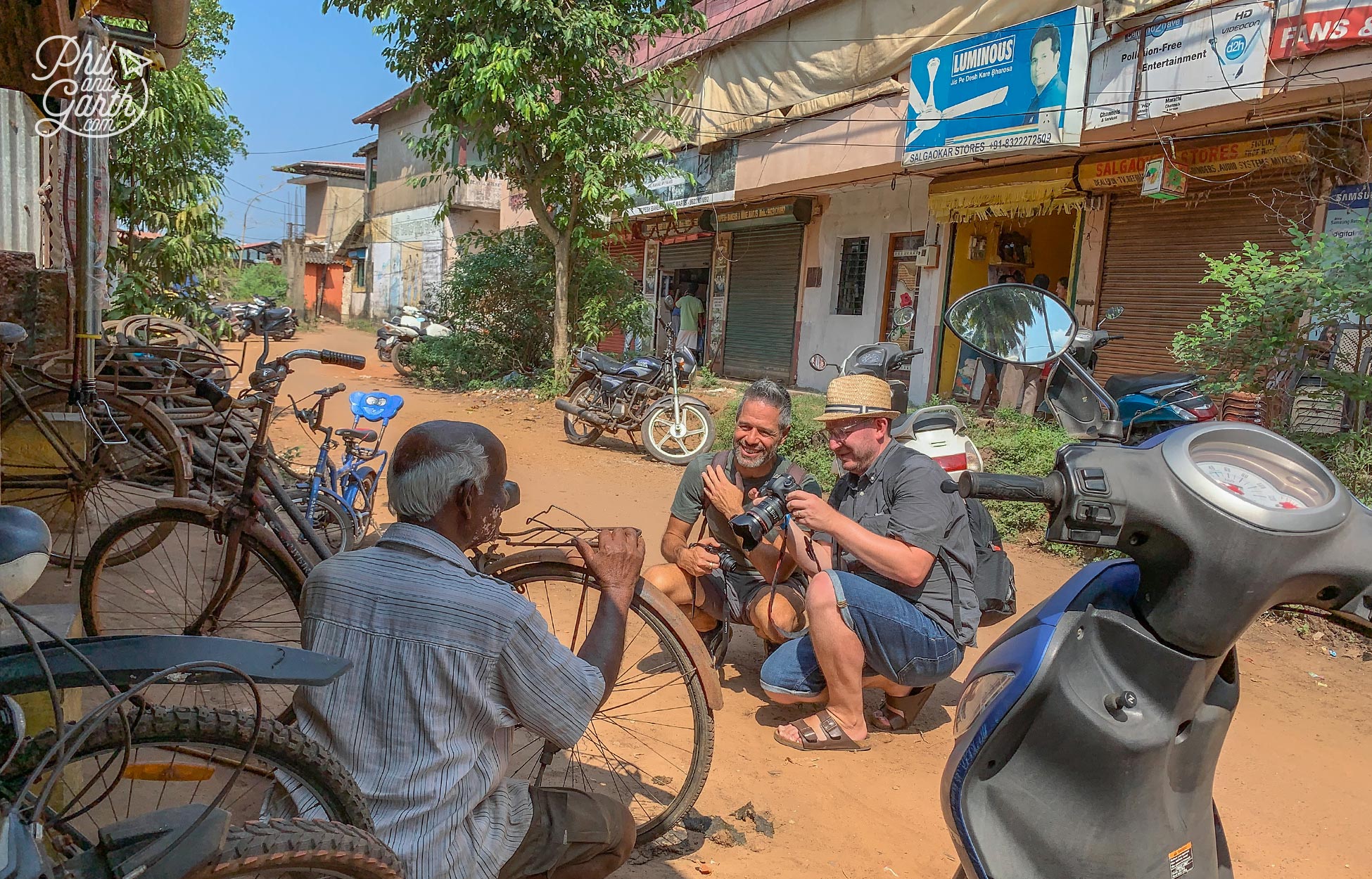
An amazing Goa photography tour with Francisco de Souza
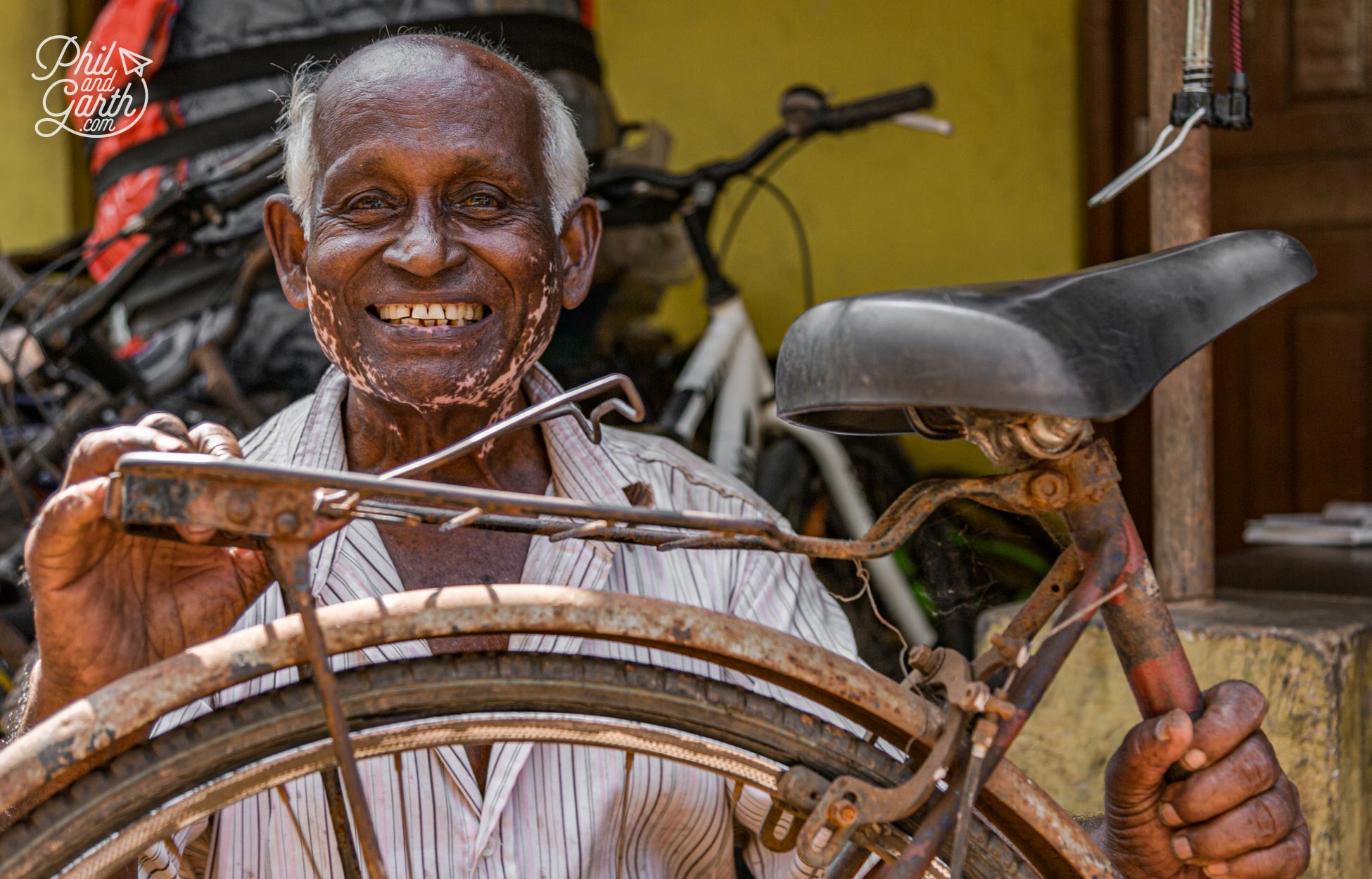
This jolly chap loved having his photograph taken
Goa Spice Plantation Tour
Another day we took a tour to the Nandanvan Spice Plantation near Ponda. Possibly not the most authentic spice plantation as it’s more of a demo spice garden geared up for tourists, however it was very interesting and more of an educational visit.
We were welcomed under a shower of marigold petals which was a nice touch and given a traditional Hindi welcome with a bindi on our foreheads. After a tasty buffet lunch and a potent Feni shot our guide showed us the various spice plants, herbs and trees. Leaves were passed around the group so we could smell the fragrance and try guess what the spice was. If you’re into cooking, then you’ll especially enjoy seeing where the spices come from.
The tour finished with a cold surprise! freezing cold water down our backs, Garth nearly died! not quite sure what that was about! but the opportunity to buy fresh sugar cane juice was most welcome. You can also buy spices from the spice shop where you exit, obvs.
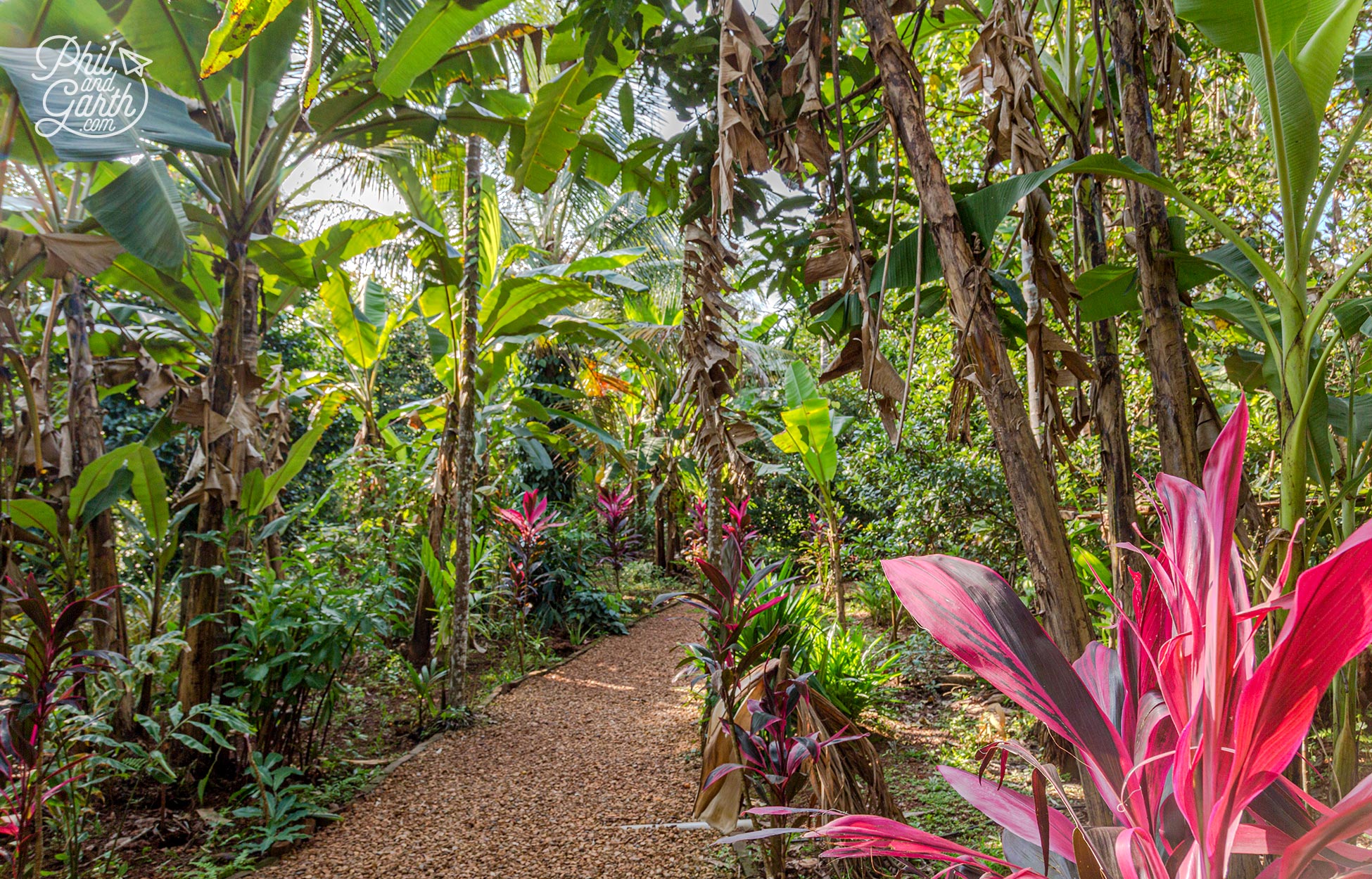
Visiting a spice plantation
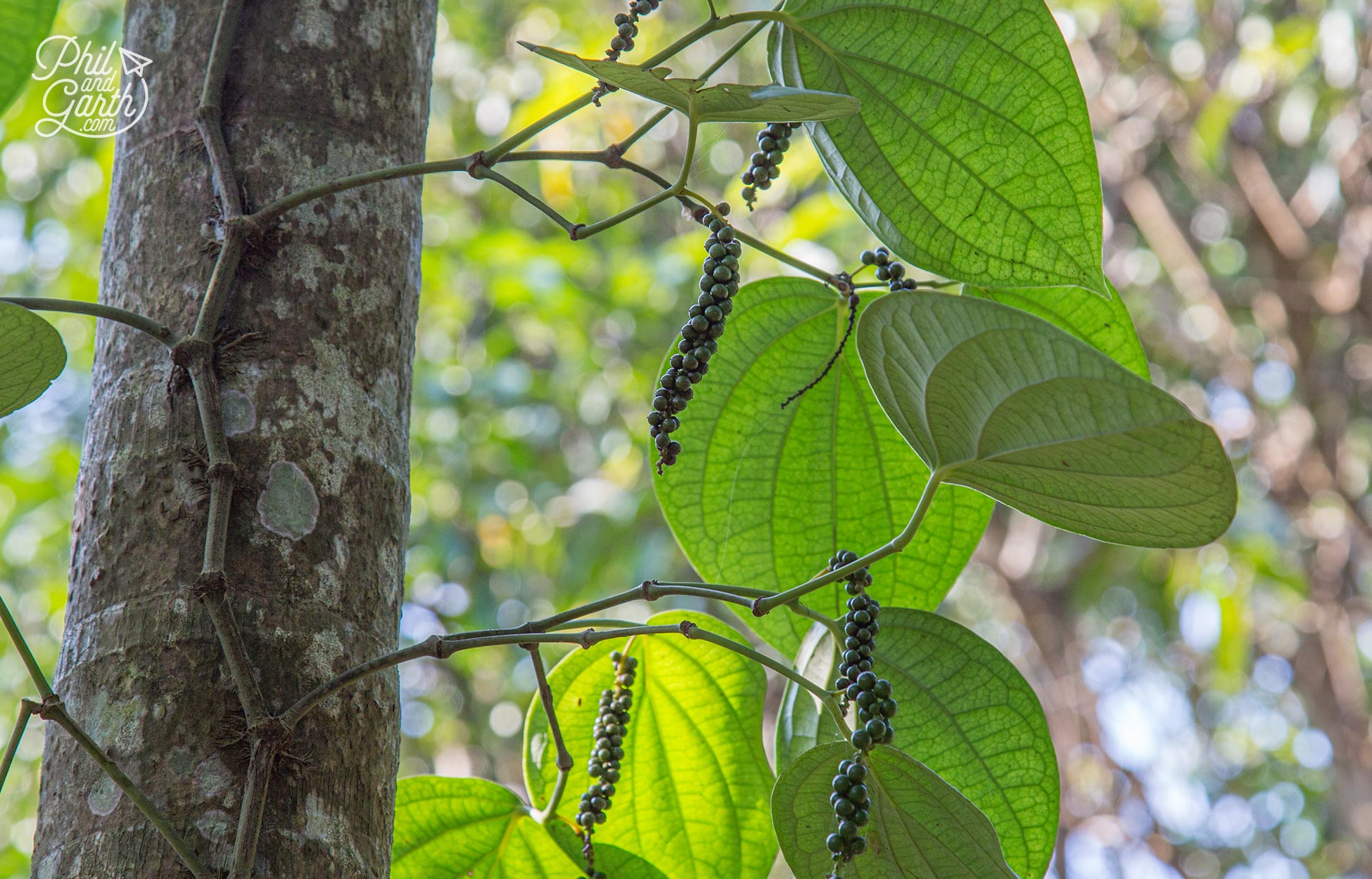
Black peppercorns growing up a tree
Goan Countryside
Driving around the countryside is really interesting, Garth loved all the matching Coca-Cola red signs featuring the same lady. They look like the red communist party propaganda signs we saw in Vietnam. Phil loved all the lush rice fields and greenery that get well watered by the monsoon season. Cows and monkeys are sacred in India, so you’ll see them all over the place, plus lots of stray dogs which you should not approach incase they have rabies.
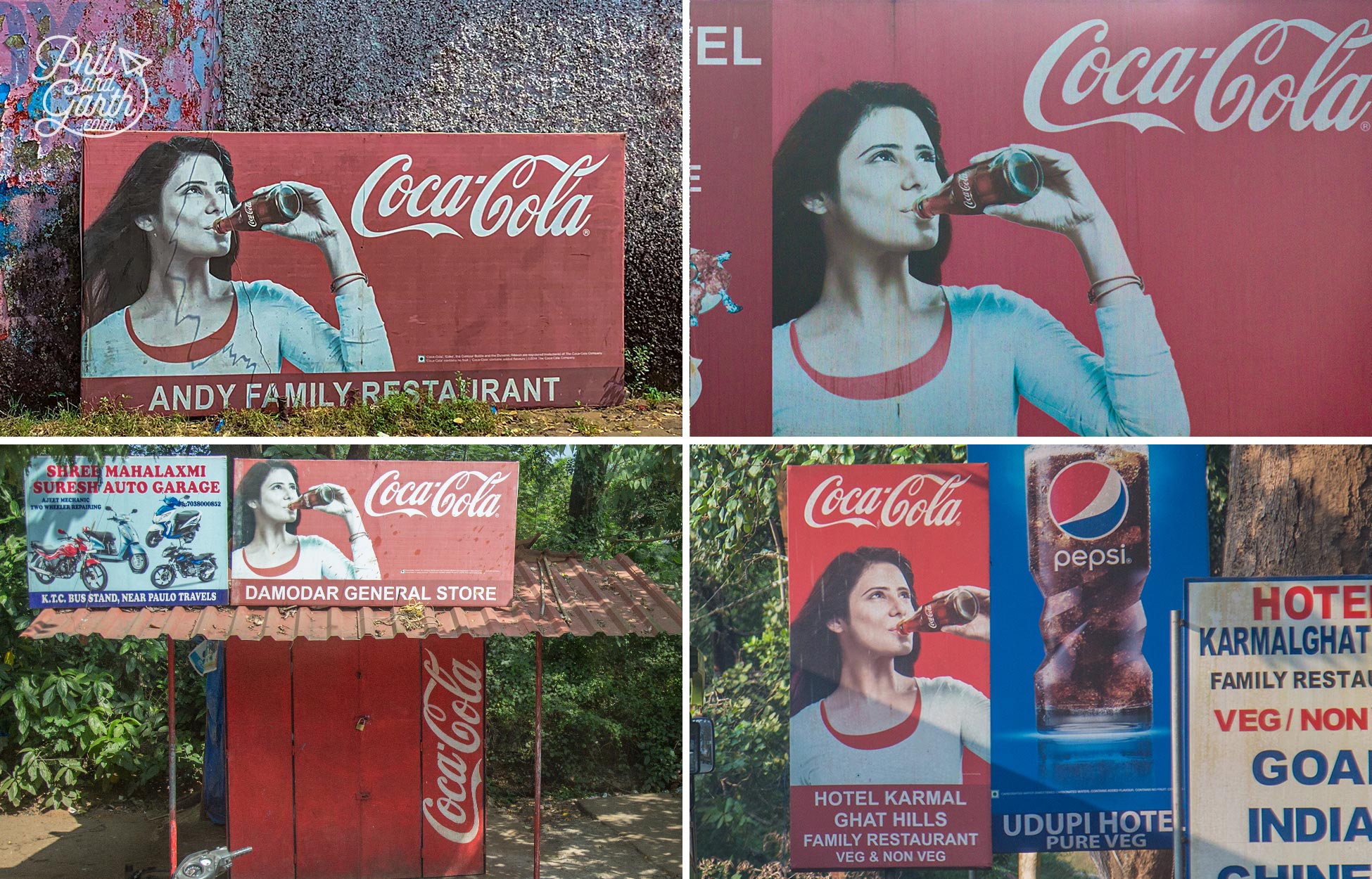
Coca-Cola signs allover Goa featuring the same lady
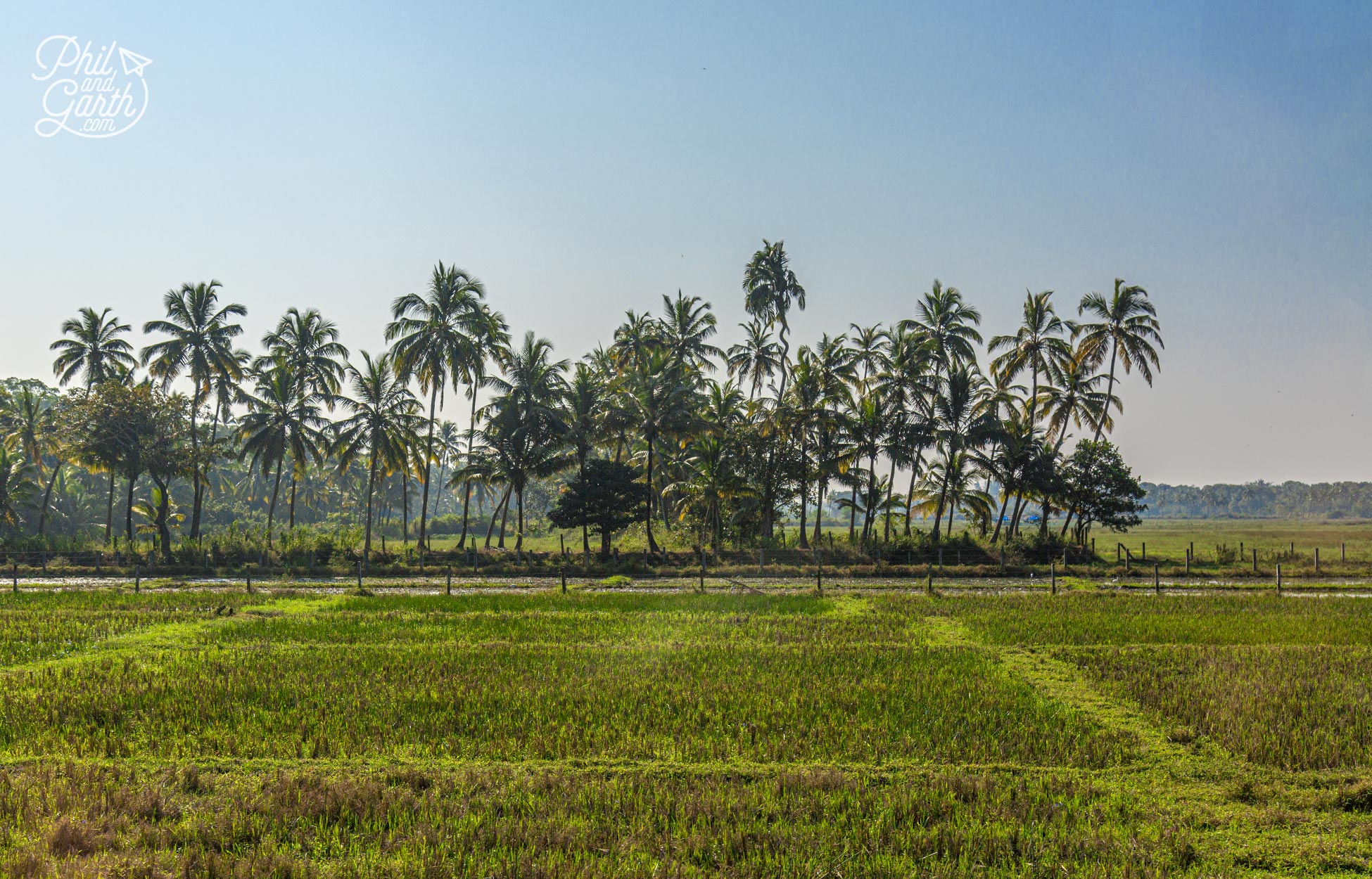
The tropical Goan countryside
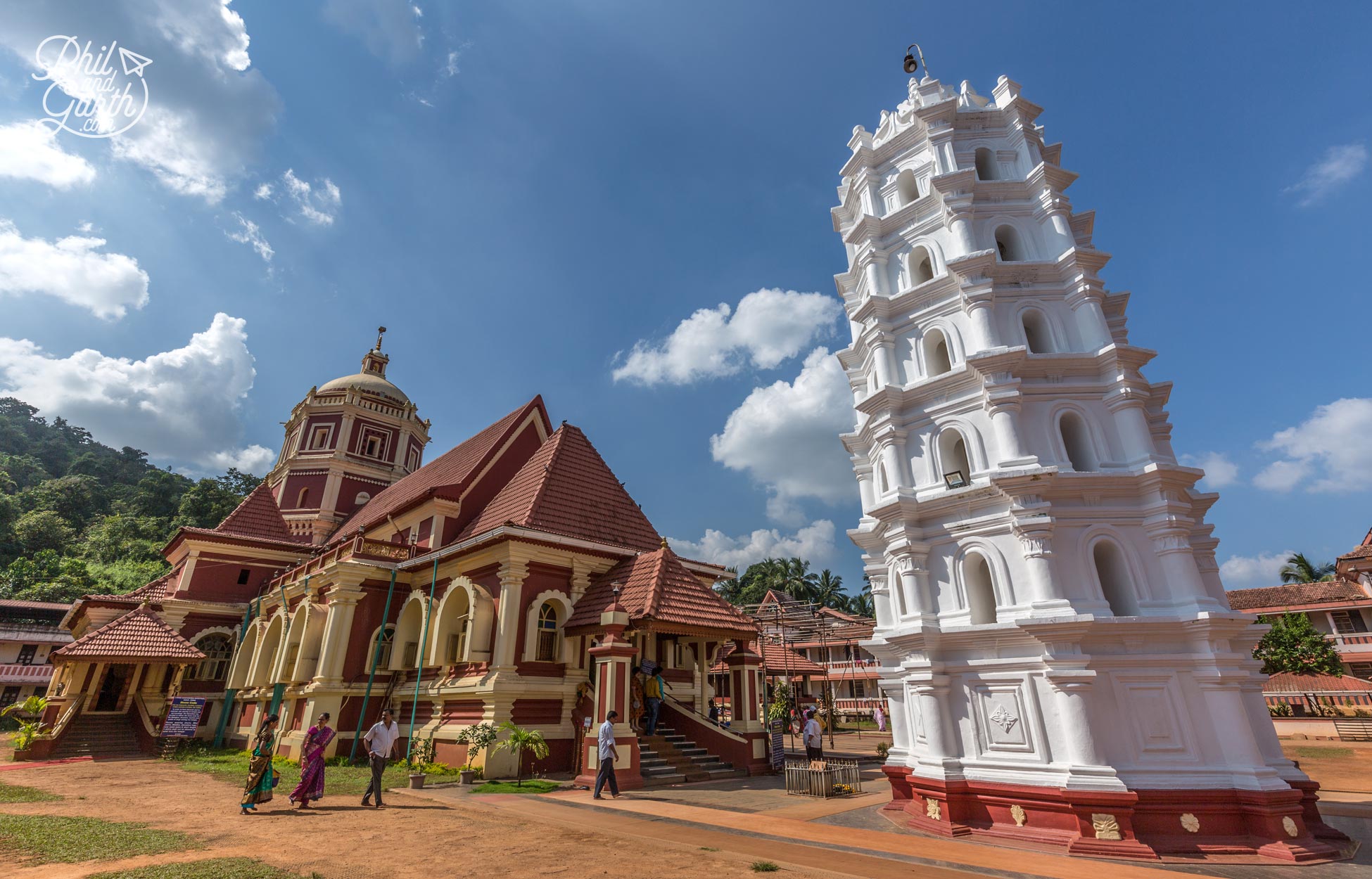
The Shanta Durga Temple – A Hindu temple in Kavalem village
Other Goa Attractions
- Dudhsagar Falls – Huge waterfall tumbling down the mountainside, nicknamed ‘the sea of milk’.
- River Cruise – Various options from Panjim.
- Yoga – Ask your hotel where to go for a local yoga & meditation experience.
- Anjuna Flea Market – Goa’s most famous flea market every Wednesday right on the beach.
- Night Markets – The biggest is at Arpora on Saturday nights.
- Mumbai – Consider combining Goa with a city break to Mumbai. It’s a short flight away and there’s lots of low cost airlines to choose from or you could take an overnight 14 hour train ride for an experience!
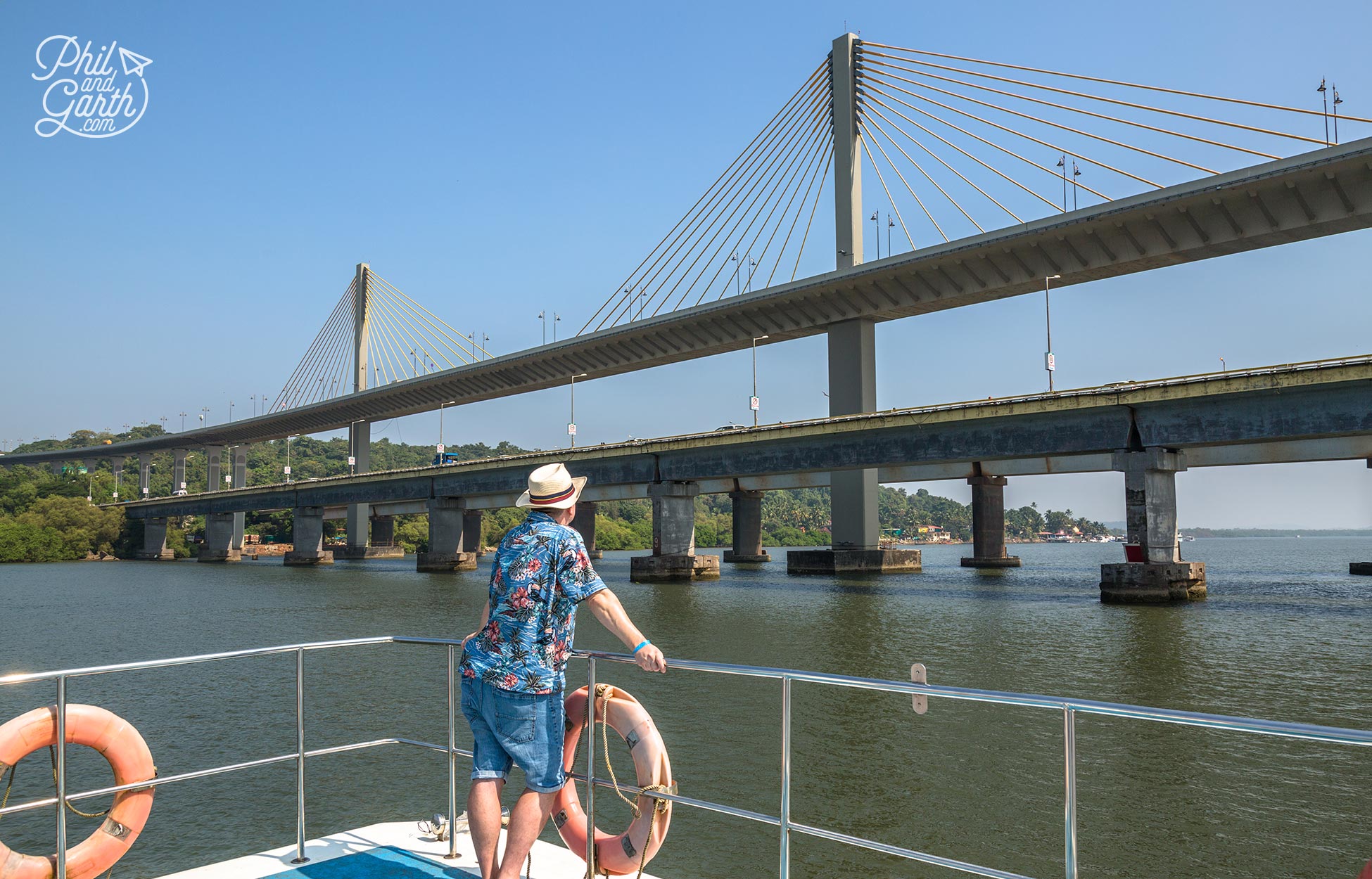
Phil onboard a river cruise from Panjim to Old Goa
Medical Tourism in Goa
What we didn’t realise before we went is the amount of health tourism that goes on in Goa. Every time we got in a taxi, the driver asked if we going to see a doctor or a dentist. Loads of Brits come here to get high quality health care done at the fraction of the price back in the UK. For £500 each you can get a full body health screen and check up done – it would cost at least double that to get it done privately in the UK. Opticians are also incredibly popular in Goa, we passed a few shops right next to our hotel. Designer frames will cost you a lot less. Dentists too – porcelain veneers anyone?!
Food & Drink In Goa
Local Goan Dishes
Portuguese inspired food is on all the menus in Goa using signature ingredients – vinegar, fiery peppers and chilli pepper. Goa makes use of the abundance of local fresh seafood and coconut milk. The mixes of religion in Goa means beef and pork tend not to be on menus, but you will find chicken and lamb. We both LOVE curries so couldn’t wait to tuck into the local dishes. We loved a vegetarian thali – a tray of little dishes, India’s version of tapas perfect for sampling a bit of everything. Goan fish curries were our favourite, plus tandoori king prawns and savoury dosas for breakfast.
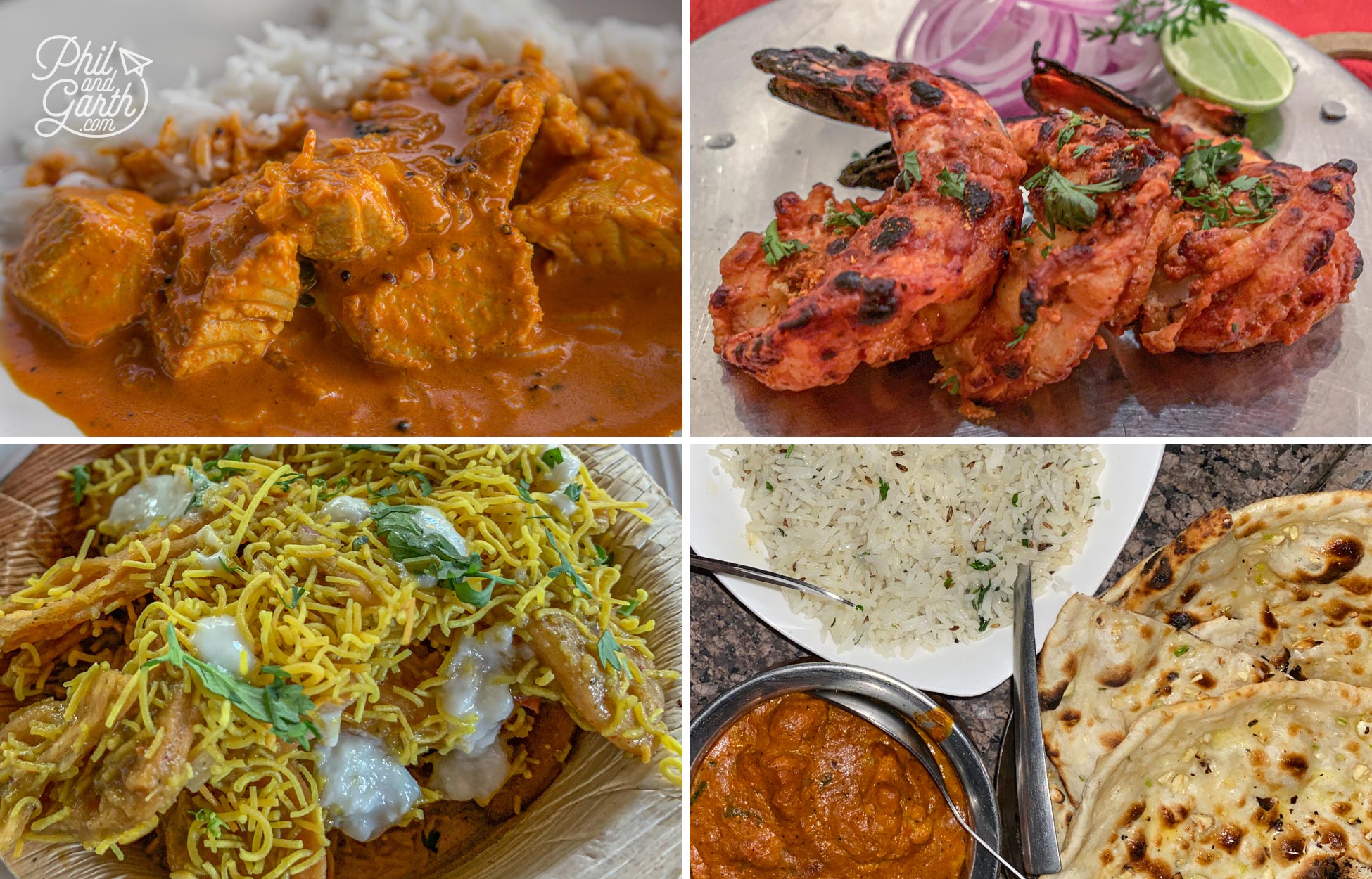
Delicious Indian food in Goa
- Xitti Kodi – or ‘Fish & Rice’ this is Goa’s signature fish curry dish. Made with pomfret or kingfish, coconut milk and raw mango gives it a tangy taste.
- Ambot Tik – A spicy sweet and sour fish curry, made with shark or catfish.
- Fish Recheado – Grilled Stuffed fish usually made with masala paste and fried onions.
- Chicken Xacuti – A popular spicy chicken curry with potato, onion, coconut, red chillies and grated coconut and poppy seeds.
- Vindaloo – The famous extra hot curry which was invented in Goa. ‘Vin’ means vinegar and ‘ahlo’ is garlic usually made with Pork.
- Sorptel – Stew of pork, offal, fat and pig’s blood – eewww!!!! (we didn’t try this one!)
- Khatkhate – A fragrant and spiced vegetable curry. Made with green beans, potatoes, carrots, lentils, coconut and curry leaves.
- Bebinca – A multi layered dessert cake made with egg, caramelised sugar, coconut and almonds.
- Samosas – Famous all over Goa. (We loved the fresh ones straight from the fryer!)
- Goan chourico – spicy sausages similar to Spanish Chorizo
- Pao – bread
- Sanna – Steamed spongy healthy and savoury bread cakes, made from rice, salt and coconut.
Local Goan Drinks
- Kingfisher – is the local Indian beer available in different strengths. Or Kings Beer which is exclusive to Goa.
- Feni – Goa’s local fiery and boozy spirt (42% alcohol) made from apples of the cashew tree. It has a smokey flavour, it’s an acquired taste, let’s put it that way.
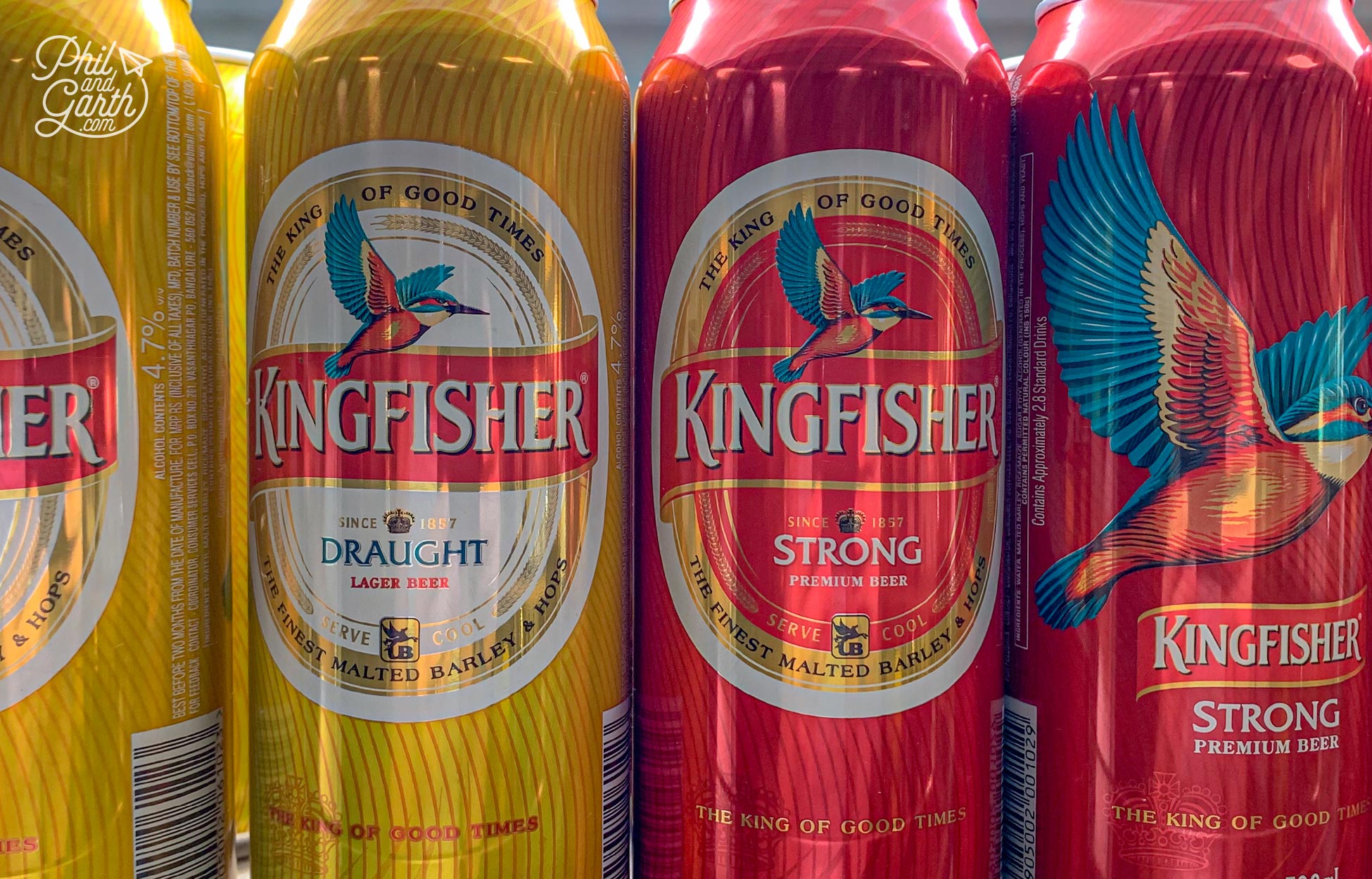
Kingfisher beer is for sale everywhere in Goa
Goa Practical Information & Useful Advice
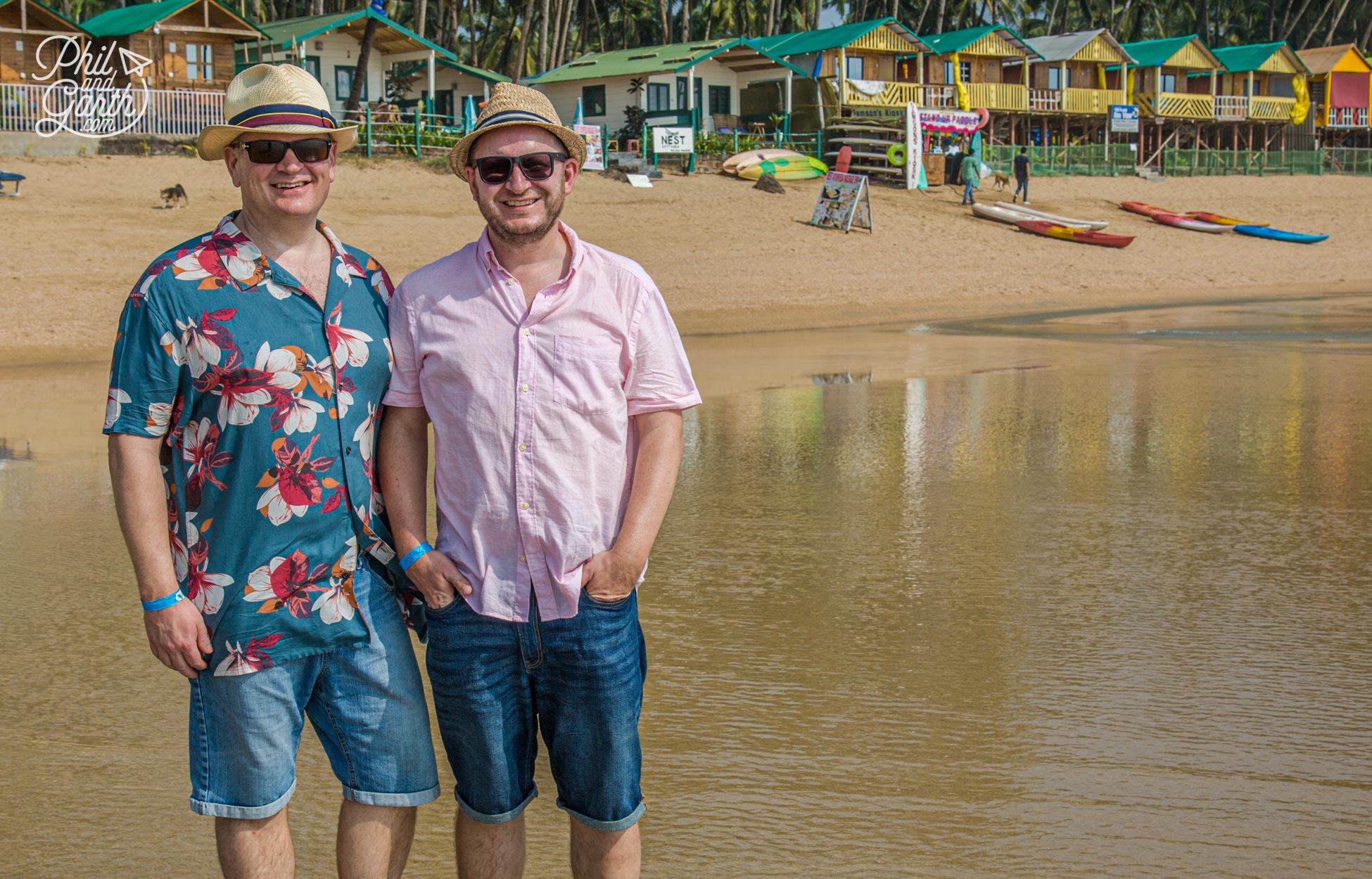
Phil and Garth’s Top 5 Goa Tips
Phil and Garth’s Top 5 Goa Tips
- Tip #1: Run your hotel shower for at least 5 mins to clear out any risk of Legionnaires’ disease.
- Tip #2: The sea has strong currents and rip tides – only swim close to the shore and in designated areas with lifeguards.
- Tip #3: Some of the roads are not in great condition, so beware it takes a while to get from A to B.
- Tip #4: Uber and Ola and not allowed in Goa, so use GoaMiles instead (you’ll need a local SIM card)
- Tip #5: Pack a torch as power cuts are common.
Goa FAQ:
- What is Goa’s airport code? GOI – Dabolim International Airport.
- What time zone is Goa? India Standard Time – GMT +5.30 hours.
- What currency is used in Goa? Indian Rupee (Symbol: ₹)
- What language is spoken in Goa? Konkani, English, Hindi, Marathi.
- What is the population of Goa? 1.8 million.
- What number should I call in an emergency? Call 100 for police, 101 for fire brigade and 102 for ambulance.
- What electricity plug type is used in Goa? Plug Types C, D & M. The 3 round pin type is the most common. Voltage is 230V / 50Hz.
- When is the best time to visit Goa? November to March is peak season.
- When is the worst time to visit Goa? June to September is monsoon season and very hot.
- What is Goa famous for? Palm fringed beaches, old churches and Portuguese style houses.
- What is a brief history of Goa? Goa was ruled by the Portuguese for 450 years until 1961 when it became part of India.
- What are the 5 must see sights of Goa? Panjim, Old Goa, Vagator Beach, Anjuna Beach and Palolem Beach.
- What local food in Goa should I eat? Xitti Kodi or ‘Fish & Rice’ is Goa’s signature curry dish.
- What’s the best way to get around Goa? Taxis are cheap and you can hire a driver for the day.
- What’s a fun fact about Goa? Goa is the smallest state in India and a third of it is covered by jungle.
- What movies have been filmed in Goa? Film location for The Bourne Supremacy and countless Bollywood films.
- Where is the best photo spot in Goa? Mapusa Market or Palolem Beach.
- Where is a hidden gem in Goa? ‘Tiger Beach’ in South Goa.
- What is the best souvenir to buy in Goa? Azulejos tiles or cashew nuts.
How we did it:
- We booked a package holiday with TUI from the UK, flying time is 9 hours 40mins
- We stayed in November for 7 nights at Novotel Goa Dona Sylvia Resort Hotel in Cavelossim, South Goa.
- North Goa Photography Tour – we booked in advance on Francisco’s website.
- Panjim, Old Goa & Spice Plantation Tour – cost £52 each and we booked with our TUI hotel rep.






